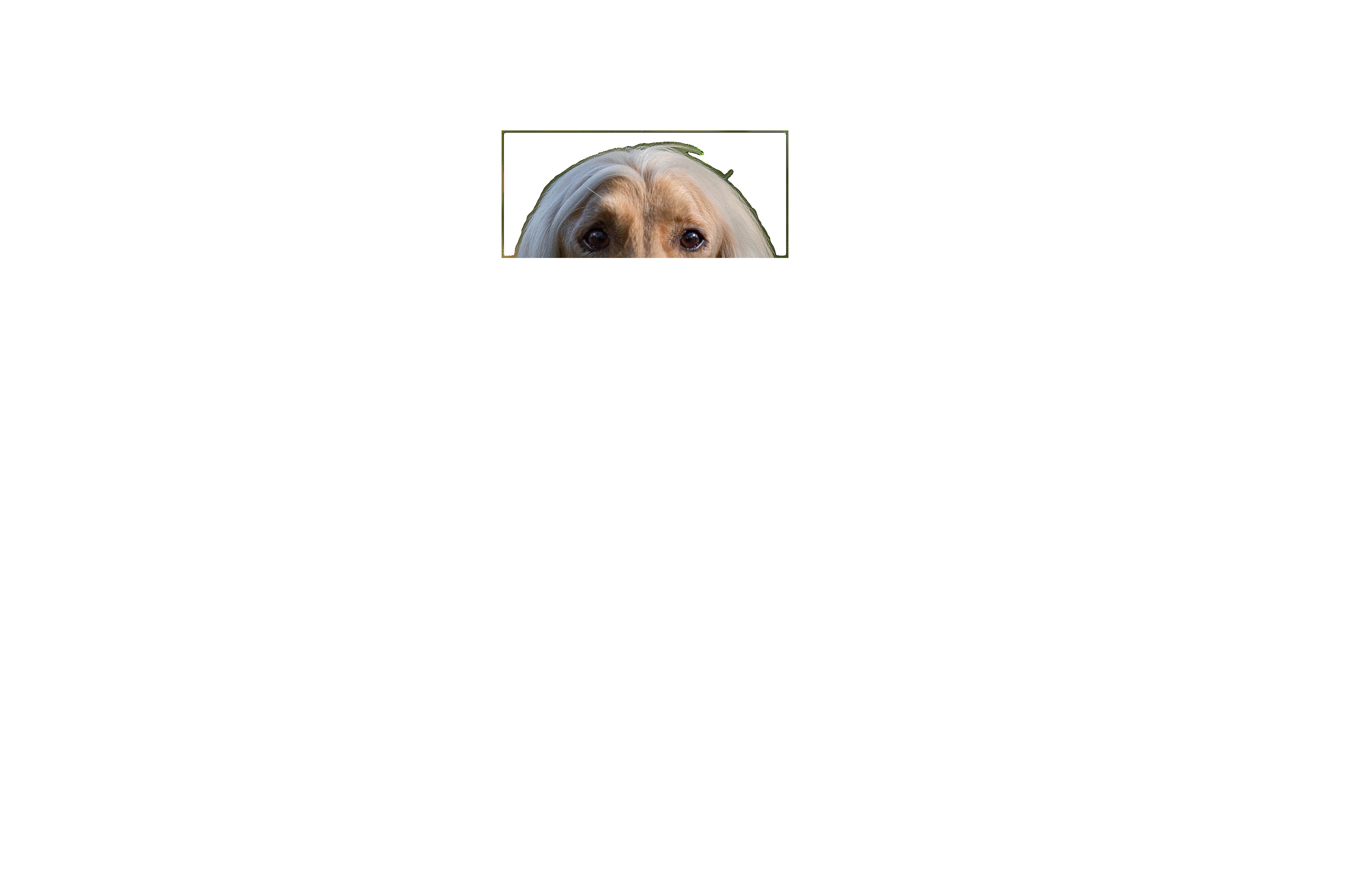

CHOOSE AWARD WINNING RAW PET FOOD JOHANNESBURG | PRETORIA | CAPE TOWN | GARDEN ROUTE | DURBAN www.paleopetpure.com & Services Pet Products awards 2023 LUXlifeMAGAZINE TEPWARTSEB F OOD MANUFACTURERSOUT H ACIRFA
Hello, and welcome to our latest edition of DQ Magazine!
This is the issue of the Afghan Hound, and we’ve had lots of fun putting it all together.
The Afghan Hound was a breed nobody in the office was overly familiar with, so lots of research has gone into bringing you this profile. The pictures of these striking dogs have kept us entertained, and we can’t help but feel that some of them should be offered leading roles in films or bands; that hair is something to behold! We hope you enjoy diving into this as much as we have, and if you have an Afghan Hound as your companion, PLEASE send us a picture. We’d love to see them!
Other content in this issue includes a selection of our competition entries for this month, a piece on why dogs deserve rest days and some tips and tricks for enriching mealtimes.
Thank you, as always, to our advertisers for their ongoing support in allowing us to bring this magazine to you free of charge. We’re immensely grateful to all of you.
If you have suggestions for content you would like to see in future editions, please don’t hesitate to get in touch; we would love to hear from you. You can drop an email to lizzie@dqmagazine.co.za or send a message on Facebook or Instagram.
Until next time!
Lizzie and the DQ team
Dr Lizzie Harrison | Editor
Designer: Anne Royden-Turner
DQ | 6C 3
xxx
IN THIS ISSUE
The Afghan Hound
The runway model of the dog world
Entries into our DQ Magazine Competition
A selection
Don't walk the dog
The importance of rest days
Enriching times
Bringing enrichment to meal times
The skin
Understanding the health of the largest organ in the body
Common neurological and orthopaedic conditions
Part 3: Fibrocartilaginous embolism (FCE) and rehabilitation
Dogs of the month
The K Litter
Understanding fostering
Woodrock Animal Rescue's Fostering Programme
AskDQ
Your equestrian questions answered
Products we love Shopping fun
DQ | 6C 4
DIGITAL ISSUE 6C | 2023


BREED PROFILE DQ | 6C 6
The Afghan Hound
THE RUNWAY MODEL OF THE DOG WORLD

BREED PROFILE
DQ | 6C 7
Tall and slender, with perfect bone structure, these stylish dogs will capture your heart. The lustrous locks, maybe black, maybe cream, maybe brindle, tumble down to the floor in silken rolls. As a saunter turns into a bounding run, each strand takes to the air and frames him perfectly. It's like a haircare advert you can't look away from. Even Jennifer Aniston can't compete with the hair of the Afghan Hound.
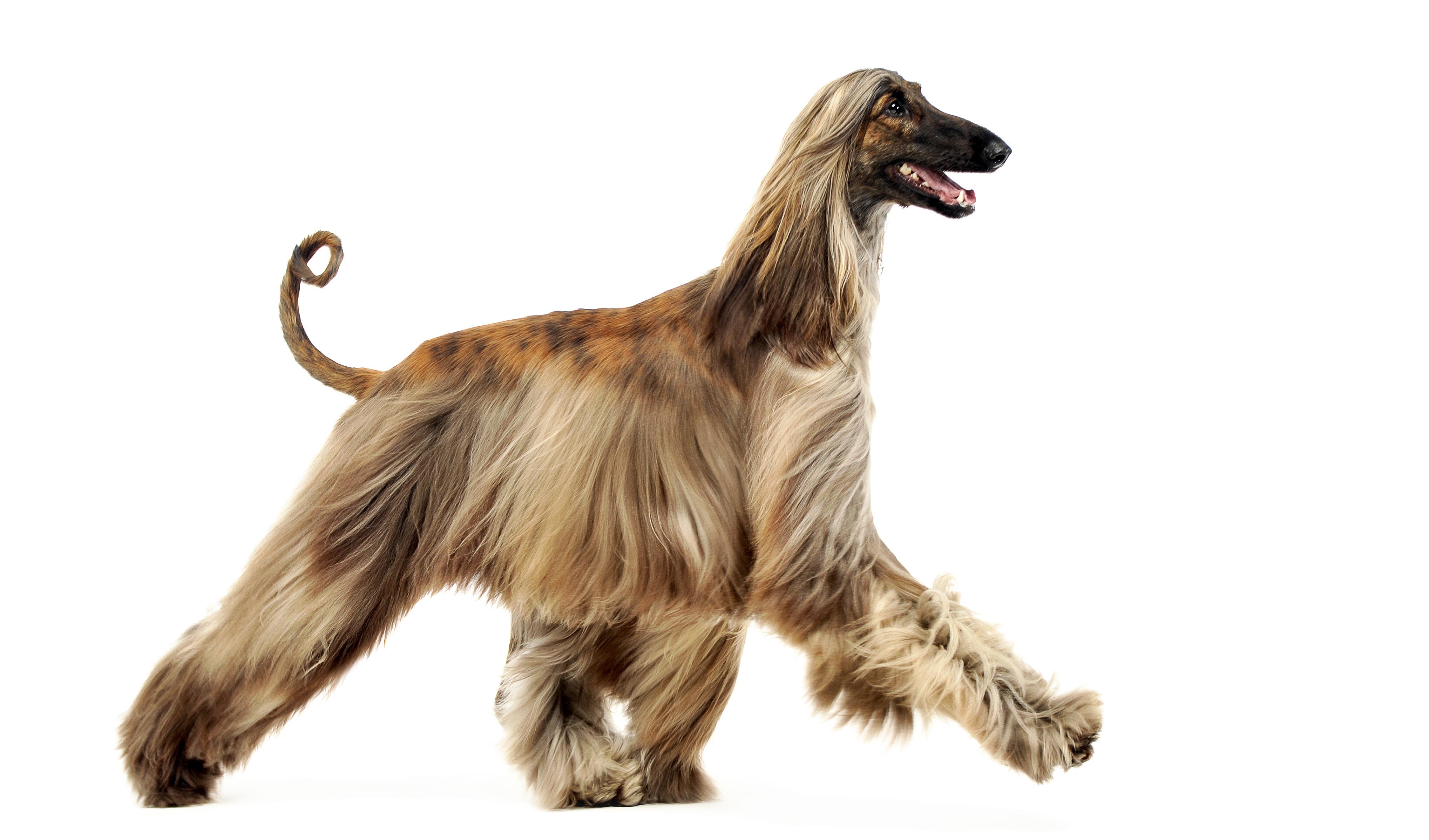
BREED PROFILE DQ | 6C 8
Looking like they have stepped off the runway in New York fashion week, the Afghan Hound is the sighthound that always travels in style. Measuring between 65cm and 75cm at the withers, these tall dogs have swinging hips, languid limbs and sizeable shoulders that give them a presence it's hard to describe.
There really is no other dog like the Afghan Hound.
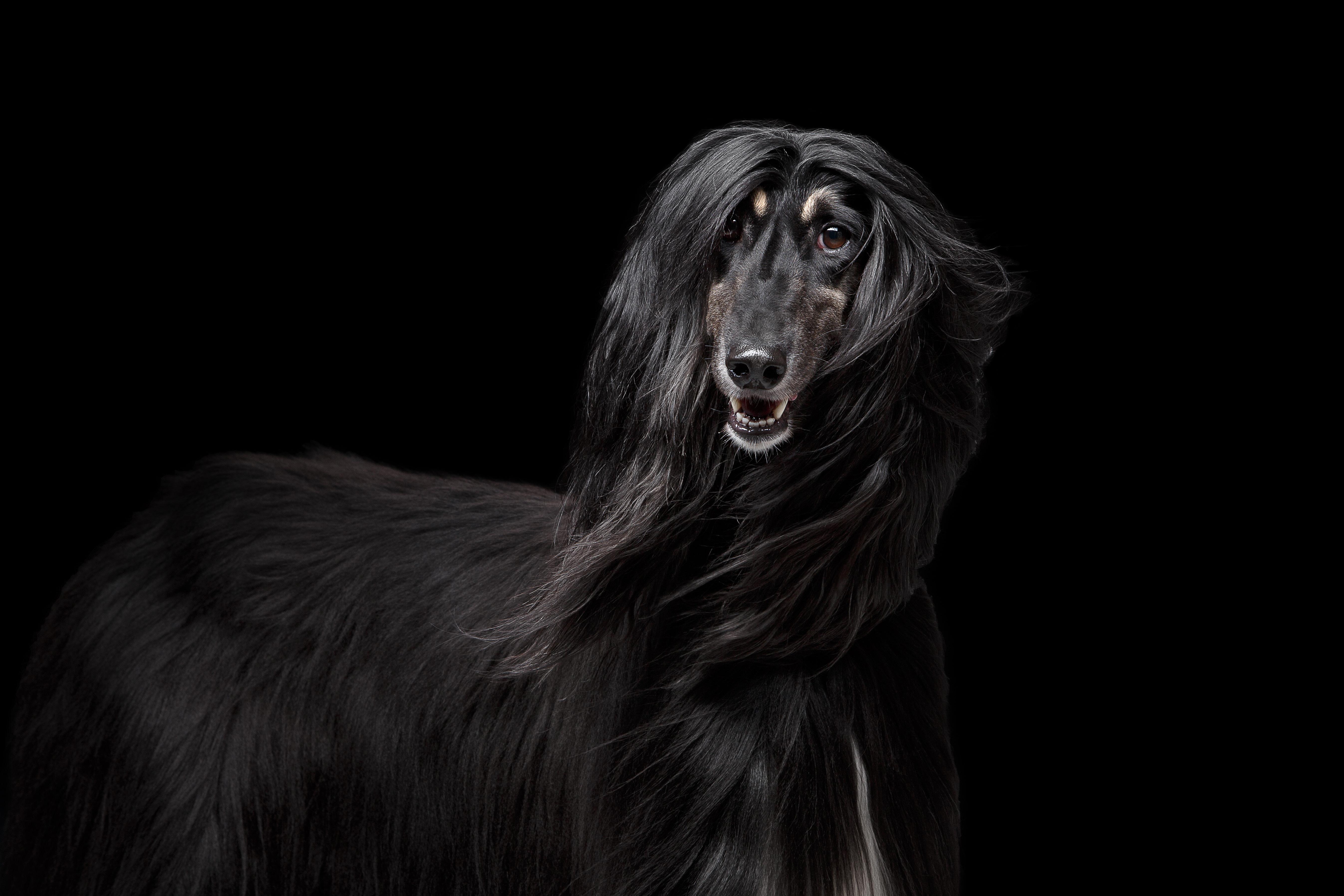

BREED PROFILE
DQ | 6C 9
HISTORY
The early history of the Afghan Hound is hard to determine. Some experts believe the hound can trace his ancestors back into ancient history, pointing to Egyptian and Greek renderings of similarly built canines. Yet, more recent research notes the lack of descriptions of the breed before they arrived in Western Europe. However, both groups of researchers agree that the modern breed developed from the various hounds owned by the nomadic tribes of western and central Asia, sharing some of its lineage with the shorter-haired Saluki and Tazy.

BREED PROFILE
DQ | 6C 10

BREED PROFILE DQ | 6C 11
The Kennel Club finally recognized the breed in 1926. A popularity boom followed, and today's dog lovers are still enchanted by the breed and its coat. Kennel Club registered and breed standard approved in every conceivable shade, the coat emerges only once the fuzzy puppy coat has come out. The process takes three years, but it's worth the wait – an adult Afghan is an iconic sight.
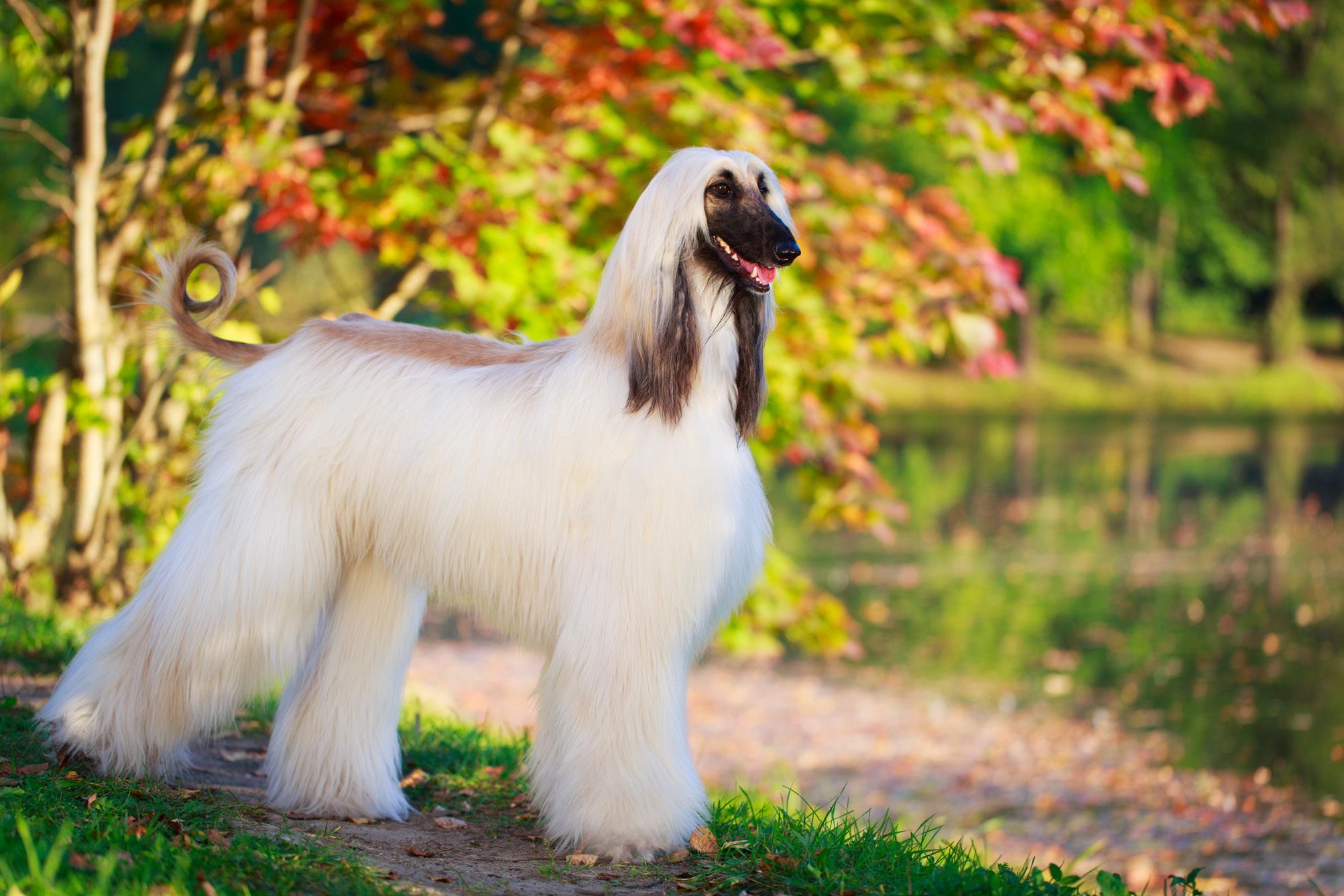
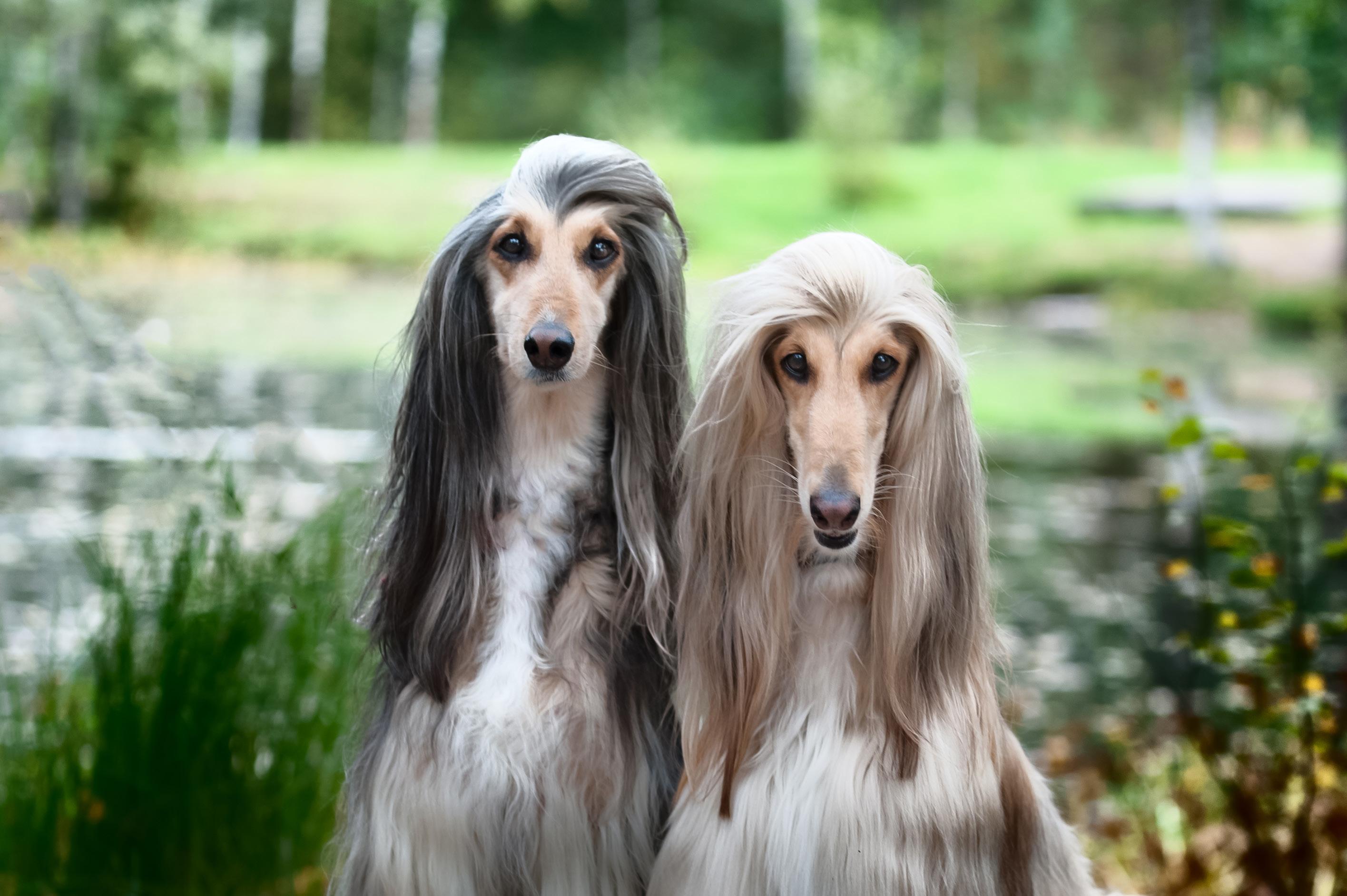
BREED PROFILE
DQ | 6C 12
THE COAT
Keeping the gorgeous coat in prime condition isn't a job for a busy dog owner. All Afghans require extensive and regular grooming. Owners need to put an hour aside, around twice a week, to catch knots and brush out the coat. Baths are less regular – with some pets lasting more than a month without a wash – but will still need to happen. Shampooing, conditioning and thorough drying, ideally with a standing hairdryer, are all key to keeping an Afghan Hound coat in optimal condition. This is a daunting process for a novice owner, and groomers will charge understandably large amounts to tackle these coats.
Having said this, some steps can be taken to reduce the intensity of Afghan coat care. Boots and leggings can be used to protect feathery leg hair from damage, while snoods which cover the ears to prevent a dog from chewing hair while they eat or explore are other common accessories.

BREED PROFILE
DQ | 6C 13
PERSONALITY
Often referred to as the 'King of Dogs,' the breed takes every chance it gets to lounge on the furniture, and they love to watch the world go by. A haughty personality can develop as Afghans mature, but this shouldn't develop into nervousness as long as they have been wellsocialized. Instead, when surrounded by people they love, Afghan Hounds can be playful and loving in equal measure. No Afghan Hound will ever be a lap dog, but they'll always tell you when they want some love.

BREED PROFILE
DQ | 6C 14

BREED PROFILE DQ | 6C 15
EXERCISE
Despite their aristocratic presence, the Afghan Hound is not built for a sedentary existence. Several hours of exercise should be part of any Afghan's daily routine, and an enclosed outdoor space is vital for the
breed's safety and health. Energetic hunters, Afghans love to dig, jump and follow the slightest sign of prey – due to their speed and tendency to conveniently lose their hearing during the chase – it's never advisable to go off-leash in public.
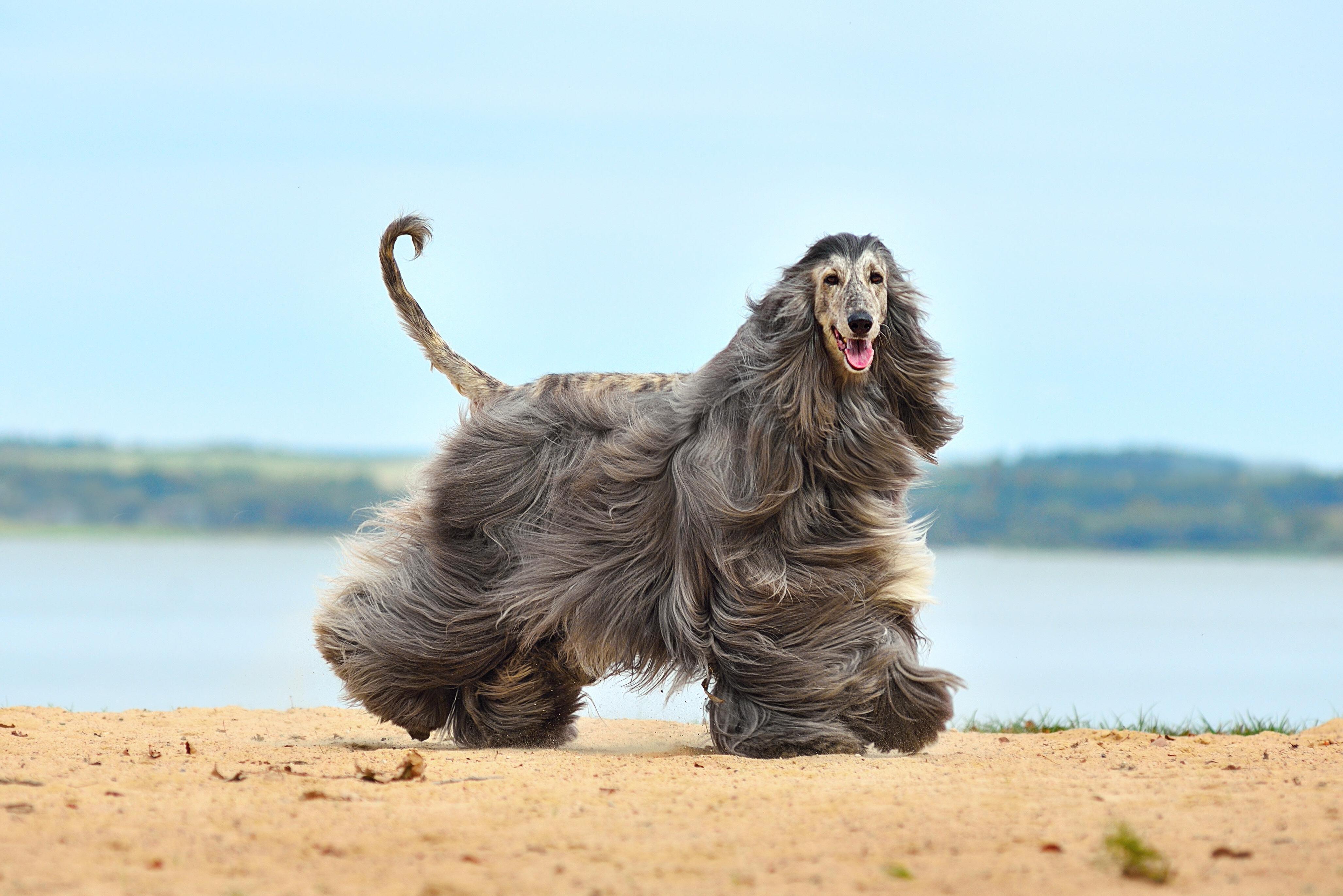
BREED PROFILE DQ | 6C 16
Many owners also enrol their pets in activities that channel the sighthound spirit. Afghan racing, which uses greyhound tracks for casual competition, fills the need for speed, while lure coursing is a firm favourite for the breed. Invented in the mid-20th century, the sport uses a remote-controlled platform to simulate the erratic movement of small mammals, prompting hounds to engage in a realistic but cruelty-free chase.


DQ | 6C 17 BREED PROFILE
Away from the sports world, any Afghan Hound will benefit from consistent training. The breed is ferociously smart and will enjoy the stimulation – just make sure they don't outwit you!

DQ | 6B 18 BREED PROFILE
DQ |
HEALTH
Afghan Hounds are not subject to many major health issues. Glaucoma and cataracts can both be issues for older dogs. Still, the average life expectancy is almost 12 years, and most surveys suggest that most of these dogs live without any diseases or long-term health conditions.
Cancer, heart disease and age are associated with most Afghan deaths, though gastric dilatation and volvulus and dysplasia can be concerns. Chylothorax – a disease where the lungs slowly fill intestinal fluid – has been associated with Afghan Hounds but remains vanishingly rare.

DQ | 6C 19 BREED PROFILE
TAKE HOME MESSAGE
One thing an Afghan Hound will never need teaching is loyalty; they quickly bond with their owners for life. The rewards of a partnership with an Afghan Hound are uncountable. They ask a lot in terms of grooming and exercise, but they give back so, so much more.

BREED PROFILE DQ | 6C 20
DID YOU KNOW?
These graceful dogs may appear like they were bred for a life of luxury, but originally they helped hunters in the deserts and mountains of Afghanistan. Once on the chase, the dogs cornered animals and kept them at bay until their owners caught up. These clever dogs can hunt independently, meaning they need very little direction when working.

FOCUS 21
ENTRIES INTO OUR DQ MAGAZINE COMPETITION
A SELECTION T
hank you to all of our readers for the huge numbers of entries we have received for our competition to win a drawing of your favourite fur baby from artist extraordinaire Merlynn Trichardt. We couldn’t resist featuring a few here, and there’ll be more to follow on our social pages in the upcoming weeks.
DQ | 6C 22 COMPETITION
ANDREA COETZEE AND CARLOS
DQ: What is your name?
My name is Carlos.
DQ: How old are you? I’m three years old.
DQ: What is your favourite activity? My favourite activity is driving on holiday with my parents.
DQ: What is your favourite treat? My favourite treat is biltong or anything on my parents’ plates.
DQ: What is your favourite toy? My favourite toy is my squeaky chicken.
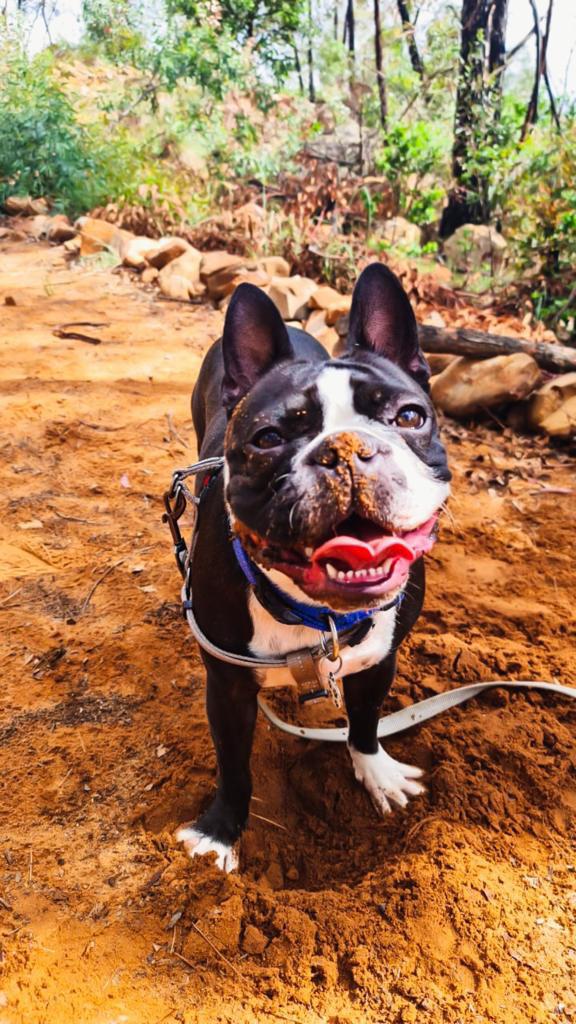
DQ | 6C 23 COMPETITION
DQ: What is your dog’s name? Lola-Belle
DQ: How old is she? Almost 2 years old (18 September)
DQ: What is her favourite activity? She loves playing with her toys and her bigger hooman brother, but I think sleeping might come in close second.

DQ: What is his favourite treat? Popcorn and peanut butter.
DQ: What is his favourite toy? Her large squeaky soccer ball and all her fuGlys.
DQ | 6C 24
MIKALA DE LANGE (LOLA-BELLE'S MOMAGER) AND LOLA-BELLE
COMPETITION
JADE BALDWIN, BRUNO AND GUS GUS
My first fur-baby (Pekingese) unfortunately crossed the rainbow bridge recently on the 7 August 2023.

DQ: What was his name? His name was Bruno.
DQ: How old was he? He was 10 years old.
DQ: What was his favourite activity? He loved napping and exploring in the garden.
DQ: What was his favourite treat? He loved anything chicken!
DQ: What was his favourite toy? He loved to play with any rope toy.
My second fur-baby (Pug):
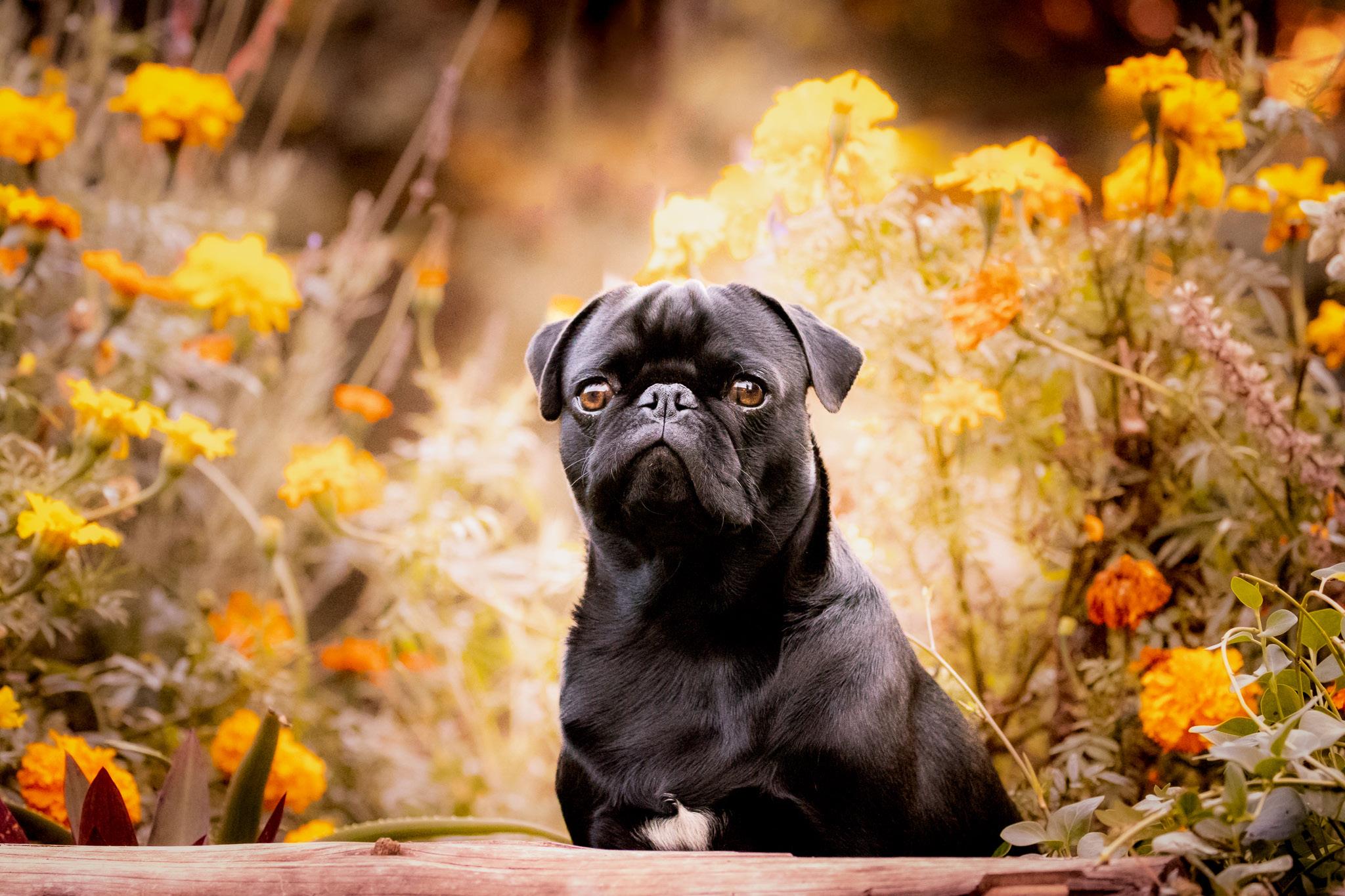
DQ: What is his name? Gus Gus.
DQ: How old is he? Two years old.
DQ: What is his favourite activity? There are too many to choose one. He loves car rides, walkies, and going on adventures to horse shows and the dog park.
DQ: What is his favourite treat? Any soft treat will do!
DQ: What is his favourite toy? Anything that has a squeaker and is fluffy.
DQ | 6C 25
COMPETITION
CRYSTAL BALDWIN AND BLAZE
DQ: What is his name? Blaze
DQ: Hold old is he? Ten months old
DQ: What is his favourite activity? Swimming and catching his tail.
DQ: What is his favourite treat? Biscuits
DQ: What is his favourite toy? Anything with a squeak.

DQ | 6C 26
COMPETITION
ANNARI CRONJE AND MILA
Meet Mila – the most energetic Border Collie! At five years old, Mila is a bundle of enthusiasm, and is always ready for her favuorite activity: Agility. She tackles every obstacle with everything she's got and just loves to please. When it comes to treats, Mila's taste buds tingle with delight at the sight of raw chicken necks – a savoury reward that satisfies her cravings. As for toys, Mila is a tugging enthusiast, finding joy in anything she can grab and playfully tug with her human.

DQ | 6C 27
COMPETITION
GENEVIEVE PERRINS AND ABBY, DEXTER AND JACK
This is Abby, and she is 12 years old. She loves playing with her brothers, especially when they do zoomies around the yard. She is absolutely obsessed with carrots and is more than happy to have them seven days a week. Her favourite toy has to be a big, purple, squeaky ball I bought for her a few years ago!
This is Dexter. He is a 9 year old Labrador. His favourite activity is definitely going on a long walk with his brother and sister. His favourite treat is a solid tie between some peanut butter dog biscuits or fresh blueberries. His favourite toy is a green tennis ball (which he loves to roll around with).


DQ | 6C 28
COMPETITION
This is Jack. He is 7 years old. His favourite activity is definitely swimming; we can’t go on a walk without stopping for a swim. His favourite treat is carrots. They’re especially delicious if he gets them as we get home from an outing. His favourite toy at home is a little dog toy in the shape of a bone, but once we’re out on a walk a big stick is always a good substitute!

DQ | 6C 29
COMPETITION
The winner of the competition will be announced on social media this week. Good luck to all who entered!
DON'T WALK THE DOG
THE IMPORTANCE OF REST DAYS

DQ | 6C 30 DOGS AT HOME

DQ | 6C 31 DOGS AT HOME
We have all heard of the many positives to be gained from regular dog walking, with plenty of documented physical and mental health benefits for both humans and canines. With many dogs (and humans) being classified as overweight, walking is crucial to improving cardiovascular fitness, blood pressure and muscle strength. Plus, going out for walks with our dogs allows us to further bond with them through new experiences. Exercise is also good for our mental health and the mental health of our canines, who need stimulation to remain healthy and happy.


DQ | 6C 32
DOGS AT HOME
SO WHY THIS ARTICLE?
For most dogs, even the most sociable and chilled characters, going out in the world is an arousing experience. Stress can be positive or negative, depending on what is happening at the time. Eustress (or positive stress) for your dogs might involve the excitement of the physical exercise of the walk or simply playing with you out in the open.
Distress (negative stress) might be caused by loud noises, too many stimulating experiences, or a difficult interaction with another dog. These distressing situations can lead to your dog experiencing an unhealthy level of stress when out and about, and these negative stresses can build up to a full stress response.

DQ | 6C 33
DOGS AT HOME
Known as the 'fight or flight hormone', adrenaline is the hormone responsible for the immediate reaction we feel when stressed. Following on from adrenaline, cortisol – known as the 'stress' hormone – is released and sticks around considerably longer than adrenaline. While adrenaline gives the body the energy and focus it needs to deal with stress, cortisol manages bodily functions like blood pressure to ensure your body is prepped for the stressful event.
Dogs need a certain amount of cortisol, but too much has negative effects. A very high level of cortisol can physically result in, amongst other things, digestive issues, a suppressed immune system, skin issues and pancreatitis.

DQ | 6C 34
DOGS AT HOME
Behaviourally, the higher the cortisol level in the dog's system, the more likely they are to be nervous and reactive. A large amount of cortisol heightens our dog's awareness. A stressed dog is more likely to react to, or show concern about, something they might generally be able to cope with, such as seeing another dog. This becomes a vicious cycle, as the stressed dog (with a high cortisol level) continues to respond in these situations with a stress response, further raising the cortisol levels.


This leads us to the topic of this article; the importance of rest days.

DQ | 6C 35 DOGS AT HOME
WHAT IS A REST DAY?
A rest day is one without any walks. It is a day free from interactions with the outside world. It allows our dogs to relax for a full 24-hour period. On a rest day, we should aim to avoid any activities that could cause adrenaline and cortisol to be released. We swap energetic movements and exercises for calm sniffing or chewing opportunities. Outside stimulation is replaced by mental stimulation – although these mental workouts mustn't overwhelm your dog and cause frustration; otherwise cortisol levels will creep up.
So, whilst society expects us to walk our dogs every single day, there are huge benefits to introducing a single rest day or multiple days with slightly reduced outside interactions in a week. Dogs need this downtime to get the full benefit from their walks on the other days of the week.

DQ | 6C 36 DOGS AT HOME
ACTIVITIES FOR REST DAYS

Rest days allow our dogs the opportunity to sleep. Many dogs get inadequate sleep each day, particularly if they live in a busy household or regularly attend events with you. Ideally, a puppy should sleep 18-20 hours a day, with 12-16 hours being the average for an adult dog. Both the length and quality of sleep affect cortisol levels. A dog that has poor sleep is also less likely to successfuly learn new behaviours as sleep supports memory function. So, if you're working with your dog on a behaviour modification programme, then taking them out into the world both stressed and without the right amount of sleep is setting yourself up for failure.
Rest days are also good opportunities for promoting more leisurely eating. Slower eating can produce a release of oxytocin, which provides pro-social benefits (feelings of connection and love) as well as a reduction in stress and anxiety. Adding some food-based entertainment, as discussed in our enrichment article this month, can help your dog have a more enjoyable and beneficial feeding schedule.
DQ | 6C 37 DOGS AT HOME
NOTE
Some pet parents use dog walks as their primary source of interaction with their canine companions. The thought of removing walks leaves them worrying about boredom or destructive behaviour. Rest days are, however, not about ignoring your dog's need for social interactions or stimulation. Rather, they are about switching walks for a different kind of activity.

DQ | 6C 38
Chewing is also a good activity for rest days. Chewing makes dogs feel good by producing dopamine, a happy hormone. Chewing can be encouraged with natural chews, appropriate-sized raw bones and food-filled toys.

TAKE HOME MESSAGE
For dogs and humans, the need to exercise and stay healthy is very real. Yet the detrimental physical and emotional implications of continually expecting our dogs to experience the stresses of life are also real. As we ask our dogs to live in a stressful human world with little opportunity to make their own choices, adding rest days to their routine is one excellent choice we can make for their wellbeing.
DQ | 6C 39
DOGS AT HOME
ENRICHING TIMES
BRINGING ENRICHMENT TO MEAL TIMES


DQ | 6C 40 DOG HEALTH
dogs, including:
• Social enrichment: Dogs are social animals and social enrichment sees us providing opportunities for dogs to spend time with other dogs, animals and people. This helps to build selfconfidence and trust.
addition of items to a dog’s everyday environment to make it more stimulating and interesting.

DQ | 6C 41 DOG HEALTH
• Feeding enrichment: This taps into the natural scavenging/ foraging instinct of the dog. By avoiding using the food bowl, your dog can be happily engaged working for his food.

• Toy enrichment: This involves the provision of toys that dogs interact with using their paws and/or
mouth to achieve a reward, such as food.
• Sensory enrichment: This includes anything that stimulates the dog’s five sense of sight, touch, taste, sound and, the big one, smell.
DQ | 6C 42
DOG HEALTH
In this article, the focus is on feeding enrichment but all forms of enrichment should be examined as options to provide your dog with a more rich and fulfilling existence. The great thing about feeding enrichment, however, is that it taps into all six categories of enrichment at least to some degree, so therefore works to enhance your dog’s quality of life in more ways than one.
A NOTE ON CANINE EATING BEHAVIOURS
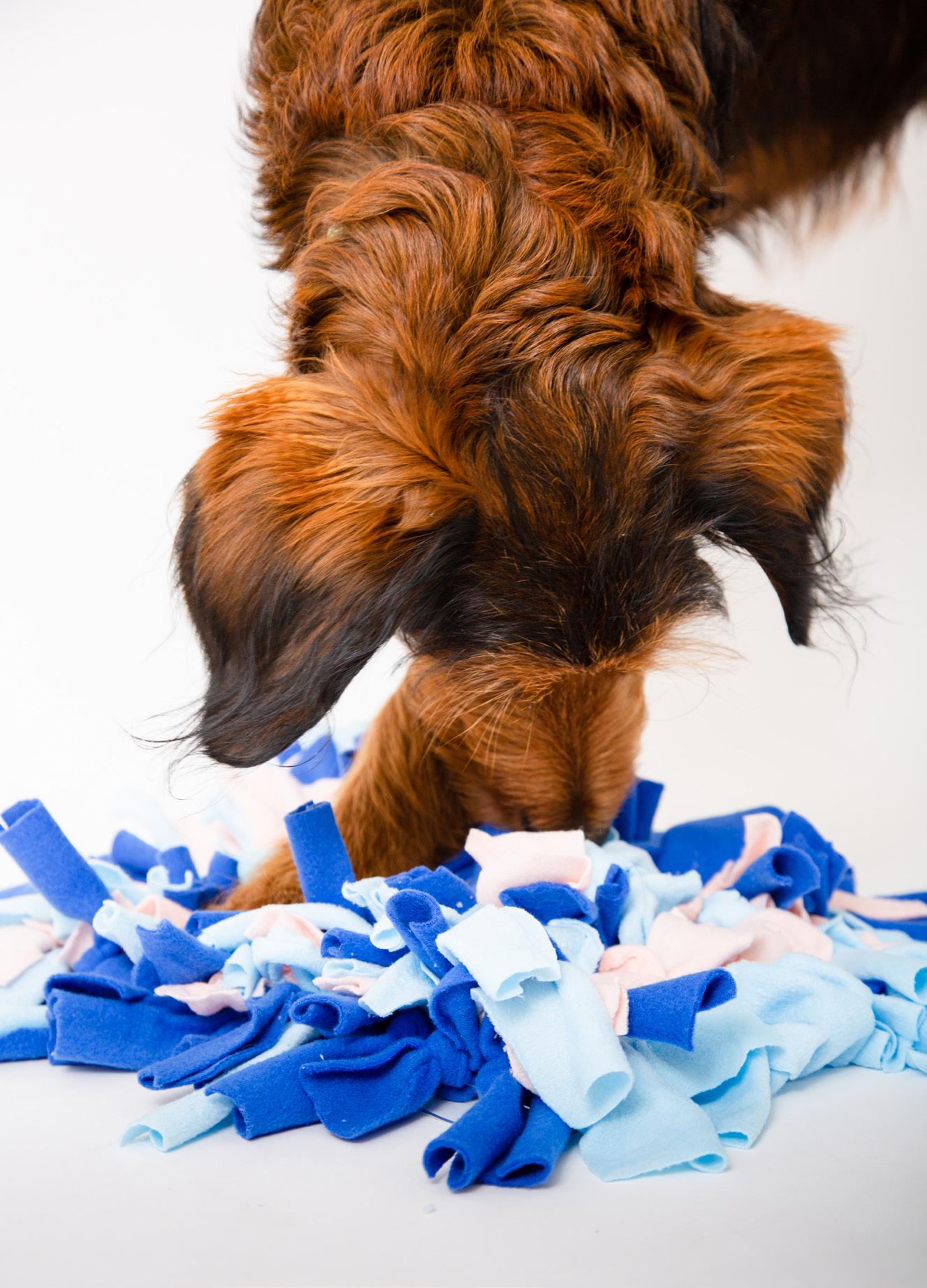
We know that dogs, if free-ranging, would spend their days scavenging, foraging and gathering food. Survival in these conditions would require a high degree of problem-solving and a lot of physical activity. This of course, is in direct contrast to the lives of our domesticated dogs, who receive their meal in a food bowl at set times of day.
Yet, it doesn’t have to be like this. By appealing to their innate tendencies of scavenging and foraging we can add something more meaningful and rewarding to their mealtime experience.
DQ | 6C 43 DOG HEALTH
BENEFITS OF ENRICHMENT FEEDING
Enrichment feeding can:
• Slow down feeding, making meal times last longer than the standard ‘30 second gobble’.
• Encourage natural foraging behaviours.
• Burn more calories in the hunt for food.
• Create a sense of achievement when food is found.
• Prevent boredom which may help to reduce separation anxiety and destructive behaviours.
• Build confidence.

DQ | 6C 44
DOG HEALTH
HOW TO MAKE MEAL TIMES ENRICHING
Instead of simply placing food in the food bowl, try these ideas:
• Scatter feeding: This is easier with dry food and can help to make meal times last longer. Scatter the food for their meal in as many areas as possible (both indoors and outdoors) for your dog to find.
• Snuffle mats: Snuffle mats are available from many places, relatively inexpensively. Dogs love to snuffle out food which gets buried into the large felt strips.
• Hiding food: This simply involves hiding treats or food for your dog to find. Make it simple at first, by letting your dog see you do it to build his confidence and understanding. Over time you can progress to more difficult hiding places, where he is not with you when you hide the food. You can also hide food or treats in a ball pit or a box of toys.
• Puzzles: Food puzzle toys such as Kong toys, treat balls and puzzle feeders can be challenging ways for
a dog to work for his food. The dog’s usual diet can be packed into these toys and if your feed wet food you can use muffin tins. These keep the dog busy for much longer than your standard food bowl! You can make the game even more challenging by filling up the feeding toy and freezing it. Top tip: Place a straw in the food before freezing and then remove this after freezing so as to avoid choking.
• Licking: Licking is very relaxing for dogs. Wet food, low fat cream cheese or peanut butter can be spread on a lick mat and can be a helpful calming aid if there are any situations which a dog finds stressful. Of course, even for nonstressed hounds, this is a great way to provide a nutritious treat.
• Chewing: Dogs love to chew as this is a natural instinctive behaviour for them. Chewing can also act as a stress reliever and may help prevent boredom when you need to be busy with something else. Dog chews can certainly help to keep your pup busy for some time!
DQ | 6C 45 DOG HEALTH
DID YOU KNOW?
There is evidence that enrichment can help delay the progression of dementia in older dogs. Dogs with canine cognitive dysfunction can still have enrichment in their lives, but try not to include anything that requires very complex problem solving. Indeed, food toys designed for puppies are perfect for older dogs too. There are also specifically designed Kongs for older dogs.
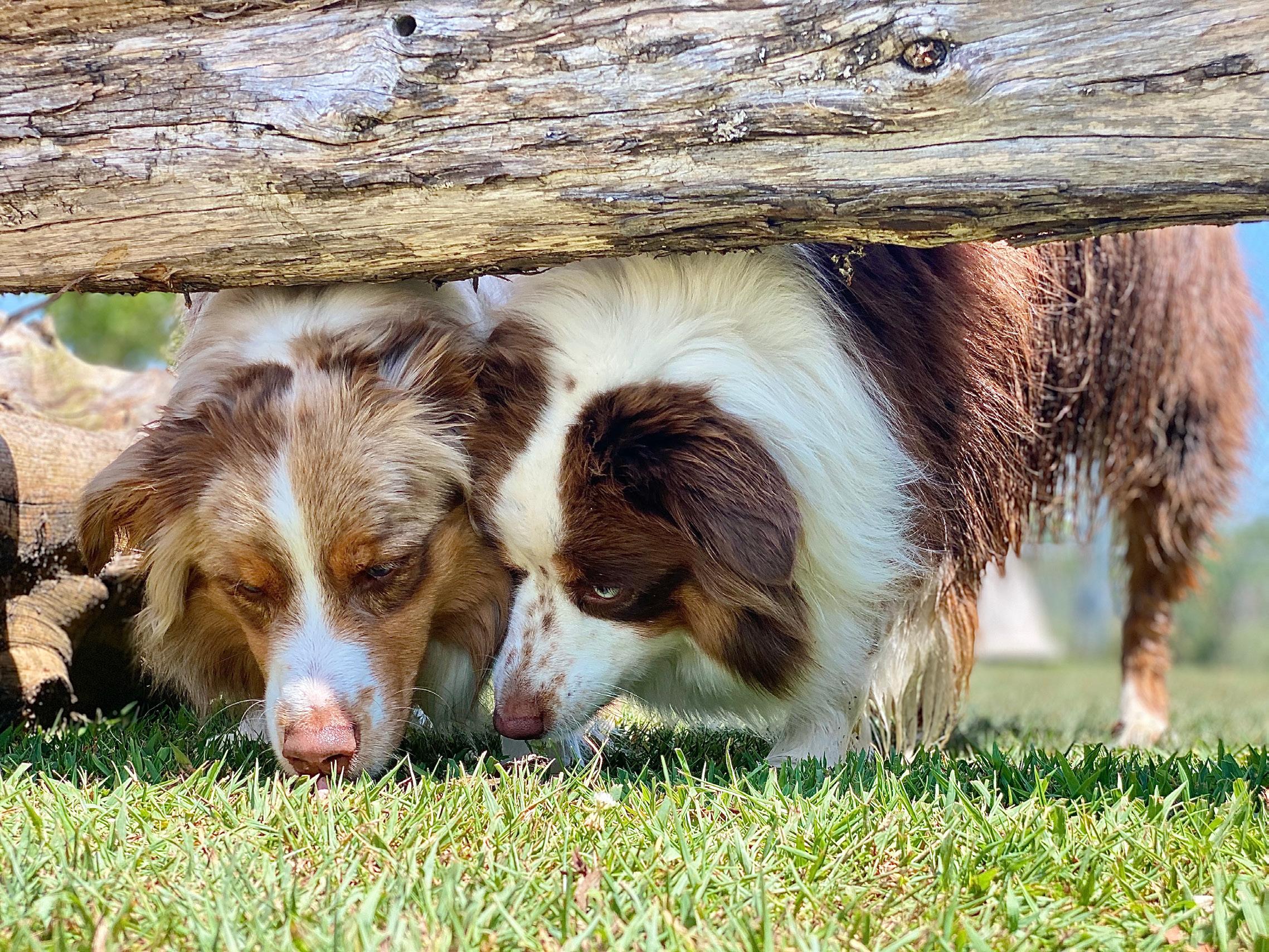
FINAL THOUGHTS
Enrichment should be challenging but not frustrating, so start easy and gradually increase the difficulty of the challenge. Help your dog to be successful, and build from there. For example, start by using enrichment methods for just one meal a day. There is no right or wrong way to use enrichment feeding, just play around and find out what works best for your dog and what they enjoy the most! Our canine companions are super smart animals an providing a variety of ways of feeding can provide crucial stimulation for them and really boost their quality of life.
DQ | 6C 46
DOG HEALTH
DID YOU KNOW?
Picasso's love of dogs is wellknown. In his lifetime, he kept all sorts of breeds, from Terriers to Poodles. He was incredibly close with a Dachshund named Lump, but his other favourite was his Afghan hound, Kaboul. Kaboul appeared in many of his paintings with his wife, Jacqueline, and his statue Tête (Maquette pour la sculpture en plein air du Chicago Civic Center) is inspired by Jacqueline but features the long nose of his Afghan hound.

FOCUS DQ | 6C 47
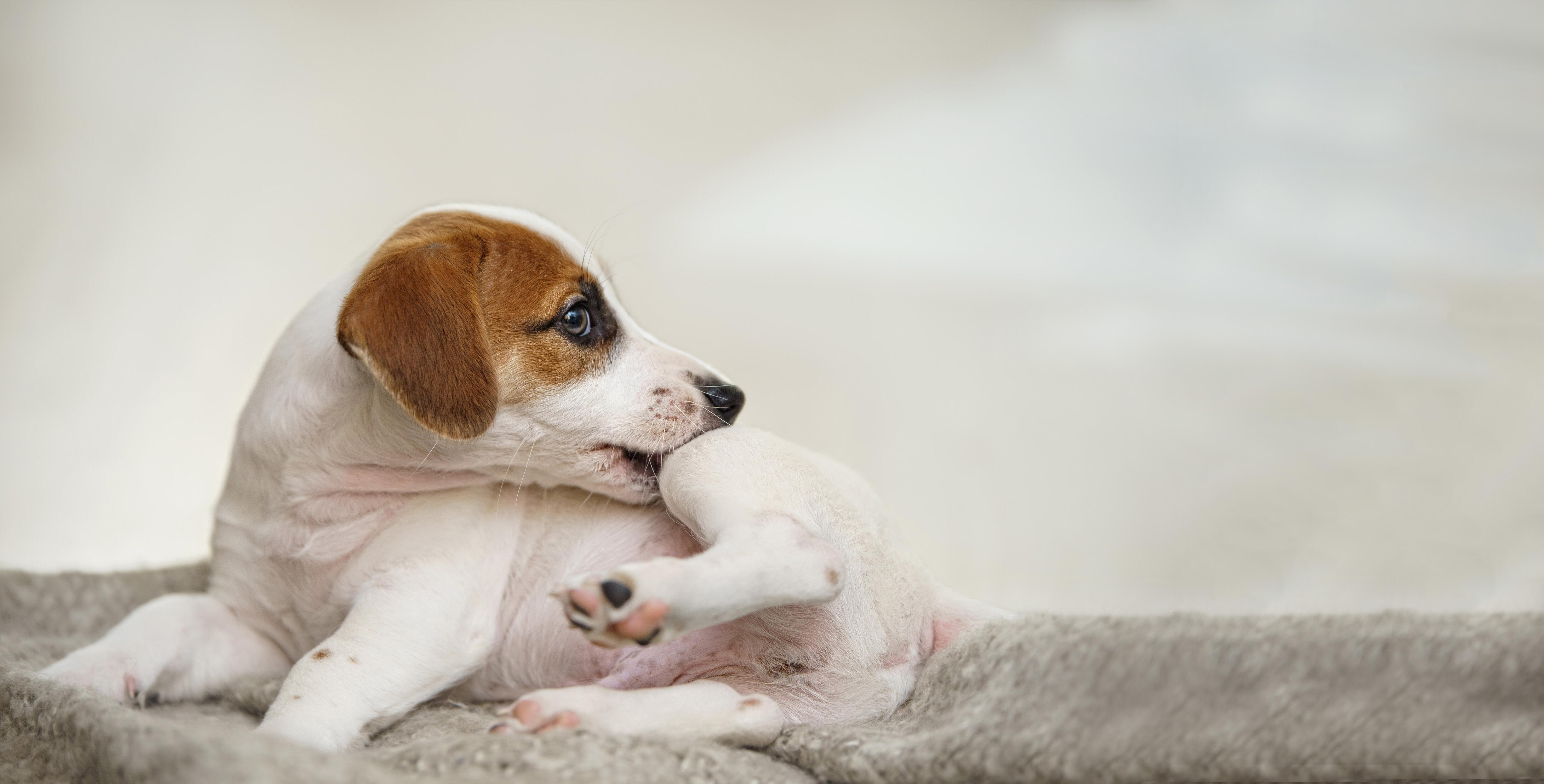
DQ | 6C 48
The skin
UNDERSTANDING THE HEALTH OF THE LARGEST ORGAN IN THE BODY
The skin comprises two major layers, the epidermis and the dermis. In terms of disease processes, the epidermis is the most commonly affected, so this is the layer we will focus on here.

DQ | 6C 49
DOG HEALTH
THE EPIDERMIS
The epidermis consists mainly of cells called keratinocytes, which make up 90% of the cells in this layer. These cells start life at the innermost part of the epidermis, and as they age, they move towards the outermost layer, flattening and dying to form a hard surface layer. This whole process takes 3-6 weeks, depending on the part of the body and the thickness of the skin in that area. The main purpose of these keratinocytes is to prevent harmful substances from getting access to the body, so they are held together with tight connections. These connections prevent bacteria and water from getting in and also prevent too much water from escaping.
Other cell types that make up the skin include melanocytes and Langerhans Cells. Melanocytes produce pigment – they are the reason why some dogs have darker skin than others. Langerhans Cells, on the other hand, are spidery cells that form part of the immune system. They act as sentinels, watching for ‘invaders’, gathering information on them and signalling to other cells that the immune system needs to attack.

DQ | 6C 50 DOG HEALTH
NOTE
Wounds and injuries to the skin increase the risk of infection developing due to the skin’s barrier being damaged and the tight junctions between cells being compromised.
DERMIS
The dermis contains the glands which produce sweat, skin oils and scent signals.
SYMPTOMS OF SKIN CONDITIONS
The skin has a relatively limited number of ways that it displays symptoms. After all, there aren’t many cells present, and each can only react in a certain way. Symptoms of skin issues include:
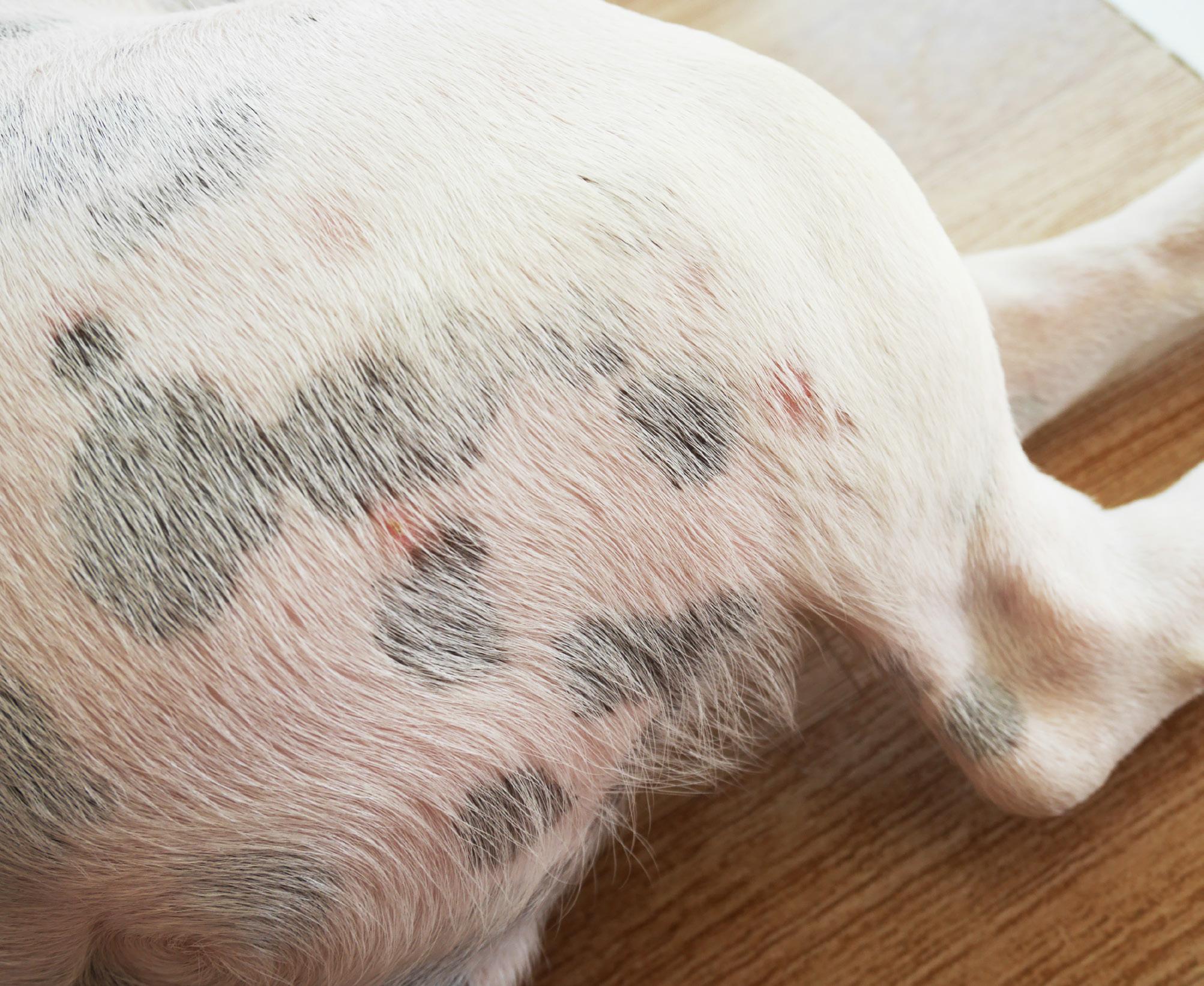
• Redness
• Spots, rashes and pimples
• Thickened skin
• Itchiness
• Hair loss
REDNESS
When skin goes red, it is usually because the blood vessels in the area have opened wide (called dilating) to let more blood flow through them. They do this in response to messenger signals from other cells, such as from the
Langerhans Cells recognising bacteria or pain signals coming from the brain. These signals are picked up by the cells in the skin, and this starts a chain reaction, ultimately resulting in the dilation of the blood vessels and the rushing of fresh blood to the area ready to deal with the threat.
DOG HEALTH
DQ | 6C 51
SPOTS, RASHES AND PIMPLES
Most rashes are red for the above reasons – the body recognises an issue and sends more blood. This is the cause of inflammation around spots and pimples too. The classic pimple contains a central pore filled with white pus, surrounded by a raised, red area. The red area is the result of the body opening blood vessels and flooding the infected pore with blood, healing proteins and immune cells. The pus in the pimple is actually all of the dead white blood cells that have been busily fighting the infection.
THICKENED SKIN
Skin becomes thicker for one of two reasons. Either the body is producing too many new skin cells (the body recognises a higher turnover of cells from inflammation and produces new cells at a faster rate to compensate), or the dead skin cells are not falling away from the body correctly (because they’re being 'programmed' abnormally and instead of dying at the correct time, they remain attached to the body.)
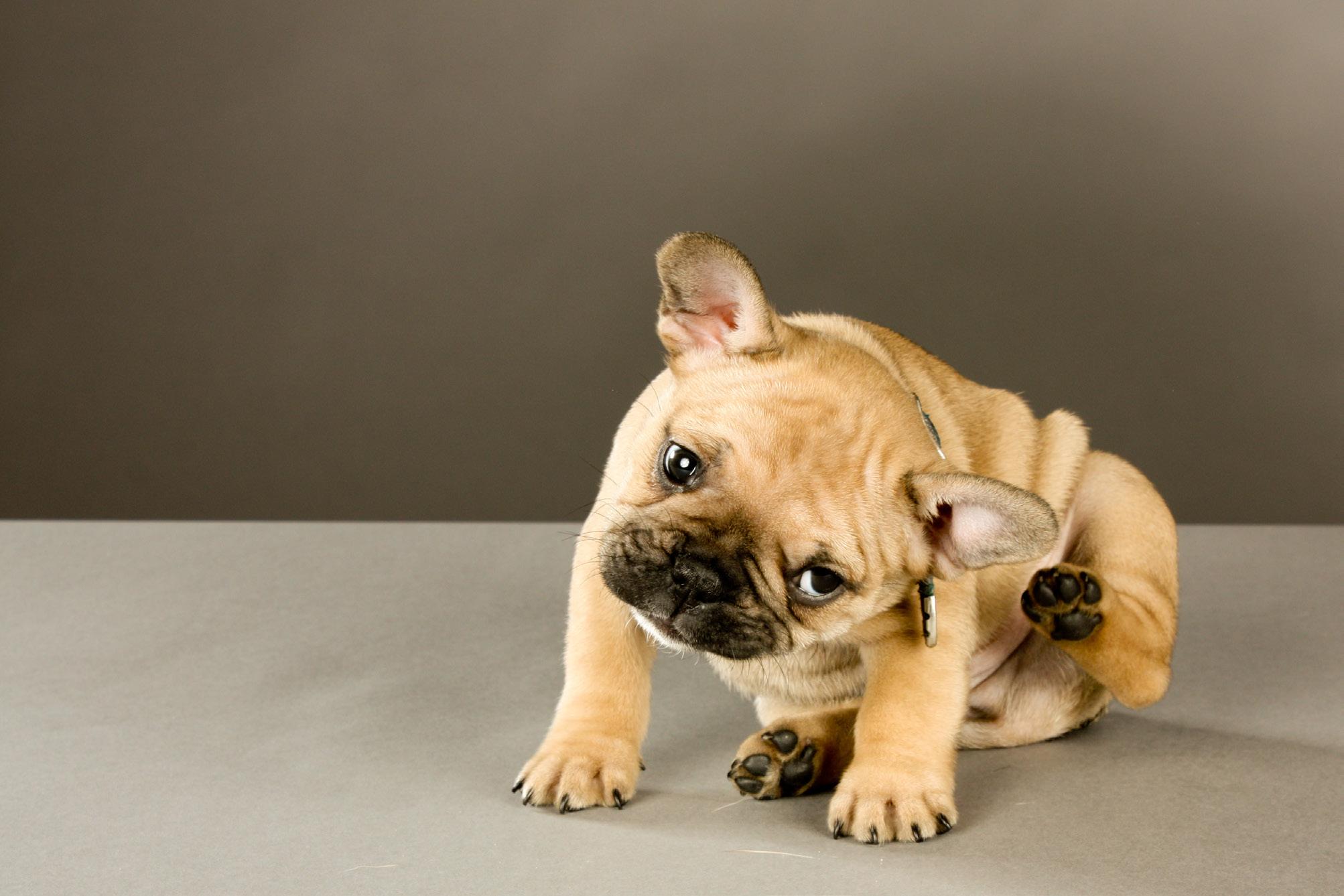
DQ | 6C 52 DOG HEALTH
ITCHINESS
Itchiness is a prevalent symptom of skin disease. In the case of allergic skin disease, there are three major steps to ‘feeling’ an itch. Firstly, the immune cells searching for bacteria and foreign bodies recognise an allergen and release a messenger. A specific receptor picks up this messenger and starts a chain reaction, which triggers nerves to transfer the message to the brain. The brain then tells the dog to scratch the itch. The problem with this is that scratching damages the skin, making it more prone to feeling itchy, something usually referred to as the ‘itch-scratch cycle’.
HAIR LOSS
Sometimes called alopecia, hair loss can occur for various reasons. Firstly, because the animal is itchy, they may break hairs early and lose more than they should due to scratching themselves. Secondly, the hair growth-loss cycle can get disrupted, usually because the hair follicle becomes inflamed, infected or invaded by parasites. This growthloss cycle can also be disrupted by hormones or stress, and sometimes no cause for this disruption can be discovered.
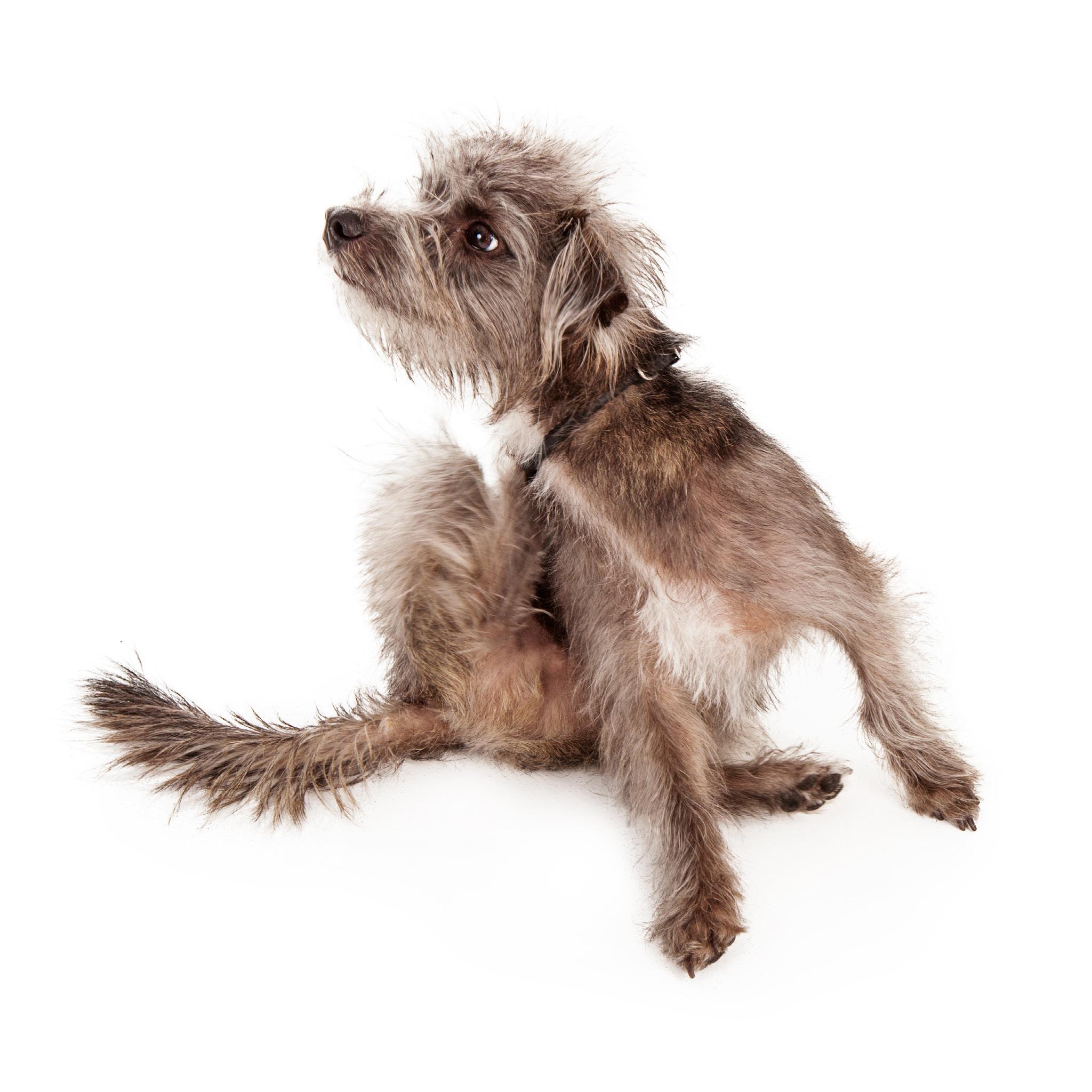
DQ | 6C 53 DOG HEALTH
COMMON DISEASES THAT AFFECT THE SKIN PYODERMA
Pyoderma is an infection of the skin. It can occur in several layers of skin. The skin can fight infections pretty well thanks to the tight junctions between cells and the immune cells living in the upper layer, so an infection usually only occurs in immune-compromised individuals. This could be young pets, older animals, or pets with diseases of the skin that affect its functionality.
Pyoderma is very itchy, and there are normally visible pimples or a rash.
PARASITE INFESTATIONS
Sadly, mites, lice and fleas are a significant part of pet ownership. These pests live in various parts of the skin, from simply hiding amongst the hairs like lice and fleas to burrowing down into the skin and follicles. These pests cause a severe itch and may allow infection in.

DQ | 6C 54 DOG HEALTH
ALLERGIES
Whilst 1 in 10 allergic dogs are reacting to something in their food, the vast majority of the rest are allergic to something in the environment. This is referred to as atopy or atopic dermatitis. For these dogs, tiny amounts of pollen or dander make it through the epidermis due to a defective skin barrier. Here, they activate the immune cells almost as if they were bacteria, causing an itch response.

TUMOURS AND GROWTHS OF THE SKIN
Tumours and growths of the skin develop due to unregulated growth of cells within the skin. There are multiple types of tumour, some benign and some malignant, such as warts, mast cell tumours, squamous cell carcinomas, melanomas and fibrosarcomas. Any new lump, bump, or sore should prompt a visit to your vet to rule out a tumour of the skin.
DQ | 6C 55 DOG HEALTH
TAKE HOME MESSAGE
Skin diseases can really affect the quality of life of our canine companions, so if you notice any symptoms of skin disease, chat with your vet promptly. As with most conditions, it is best to get them dealt with early to both improve your dog’s comfort levels and minimise the damage caused. Several drugs are available for treating these conditions, including surgical options for tumours, and your vet will be best placed to decide which will best help in your particular scenario.

DQ | 6C 56
DOG HEALTH
DID YOU KNOW?
The Afghan hound is not only quick but also incredibly agile and able to make the tightest of turns. This is due to their unusual hip placement; their hips are higher and wider apart than those of other breeds, allowing them to easily manoeuvre around the uneven terrain of the Afghani mountains.

DQ | 6C 57 FOCUS
COMMON NEUROLOGICAL AND ORTHOPAEDIC CONDITIONSCAN REHABILITATION HELP?




FIBROCARTILAGINOUS EMBOLISM (FCE) AND REHABILITATION


In the third part of our series, we will explore a not so common neurological disease, a Fibrocartilaginous Embolism, or FCE.
 Text | Bianca Rootman
Text | Bianca Rootman
DQ | 6C 58
WHAT IS AN FCE?
An FCE, otherwise referred to as a spinal stroke, can be a scary condition to deal with due to the speed at which it occurs. An FCE is caused by a small piece of cartilage from the intervertebral disc coming loose and blocking blood ow in the spinal cord. The blockage causes tissue in the spinal cord to die off, resulting in a stroke. The condition generally affects adult large or giant breed dogs and does not commonly occur in chondrodystrophic breeds such as the Dachshunds.

DQ | 6C 59
WHEN DOES IT OCCUR?

An FCE usually occurs during an activity such as running or jumping. Your companion may cry out and then suddenly be unable to stand or use their limbs properly. The stroke’s severity depends on where it occurs in the spinal column and the size of the blood vessels affected. Higher up, closer to the head of the dog, all four limbs could be affected, whereas lower down in the spinal column, only the hind limbs are affected.





In most cases, symptoms will progress quickly within one to two hours of the injury. The condition is not painful after it has happened, so this is one way your veterinarian can make a diagnosis. Your veterinarian will also rule out other conditions such as IVDD (Intervertebral Disc Disease), thromboembolic disease associated with cardiomyopathy, spinal trauma, myelitis and neoplasia.

DQ | 6C 60
TREATMENT

No surgical treatment is available for an FCE, and no medication makes a signi cant difference. The key to recovery is management and rehabilitation. The rst month is the most critical, and therapy should start immediately after diagnosis. If your companion is completely paralysed and cannot move at all, intense nursing care is required to prevent any more complications, such as bed sores and urine burns. Home management, such as preventing slips and falls for compromised companions, is vital.
The goals of therapy are to regain ambulation, prevent muscle atrophy, improve limb function and alleviate secondary pain caused by tension. Therapies include acupuncture for pain and improved nerve function; Electrical Muscle Stimulation (EMS) to improve muscle mass and strength; LASER (light therapy) to increase the healing rate; and massage therapy to help with compensatory pain. Most important are the active exercises such as underwater treadmills and land-based exercises to increase strength and proprioception. These exercises will also focus on gait training to teach your companion how to walk again. About 85% of patients fully recover; some patients can be left with some sort of weakness or disability, for example, paralysis or a weak limb.
DQ | 6C 61
TAKE HOME MESSAGE
This can be a challenging condition to deal with, but proper home management, combined with an intensive therapy program, will ensure the best possible chance of recovery for your companion.

ANIMAL HEALTH AND HYDRO RYNFIELD
154 President Brand Str, Ryn eld, Benoni
Contact: 083 230 2188
Email: animalhealths@gmail.com

ANIMAL HEALTH AND HYDRO PRETORIA EAST
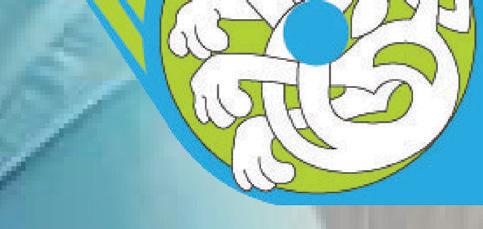
218 Mark St, Grootfontein County Estates, Pretoria East, Grootfontein Country Estates
Contact: 074 251 4410
Email: ahahpretoria@gmail.com
DQ | 6C 62
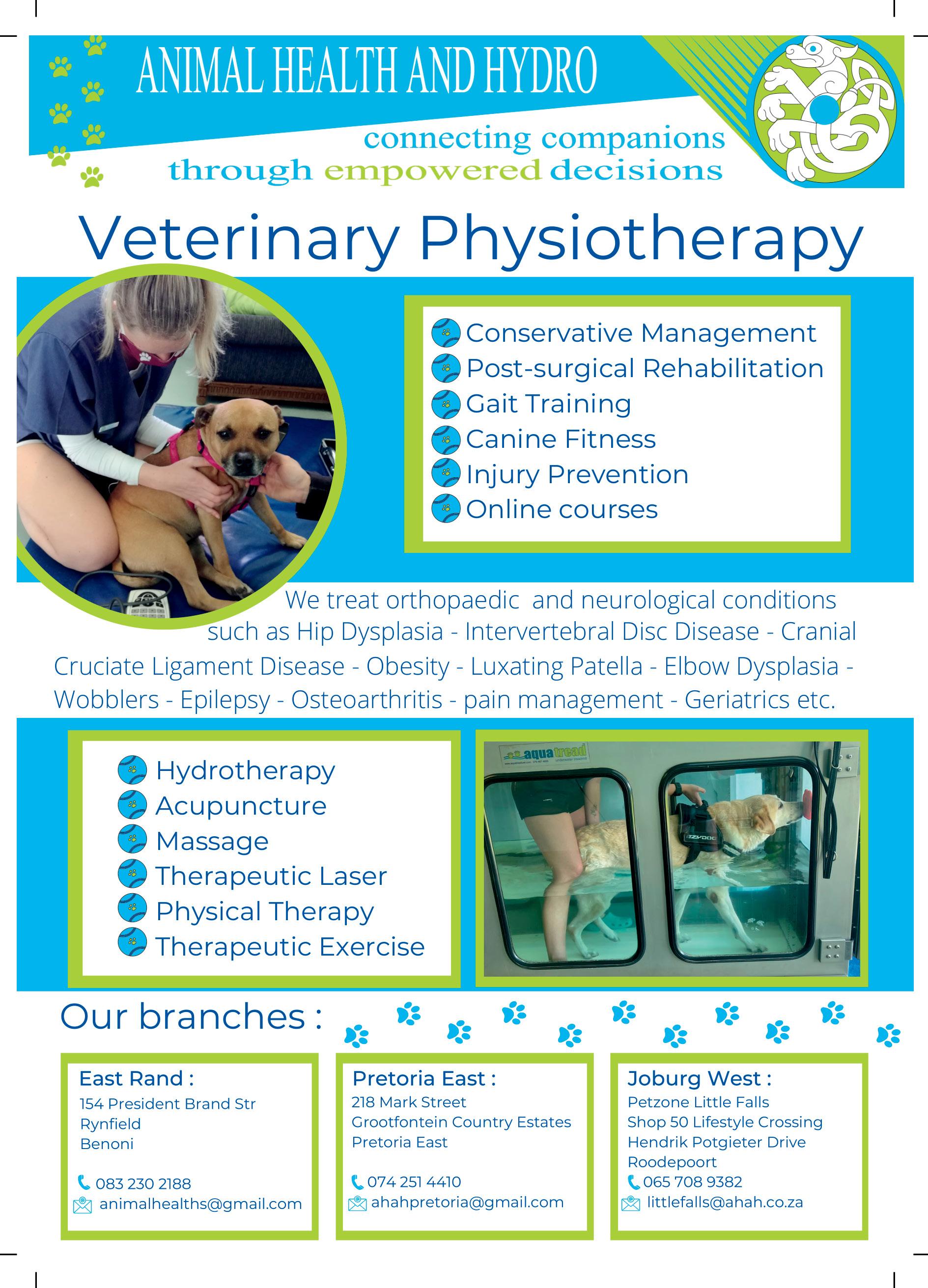

DQ | 6C 64 WELFARE
Dogs of the month
THE K LITTER
The K litter is a story of fostering success, highlighting the need for more willing foster parents to step into this crucial, yet challenging, role.

DQ | 6C 65 WELFARE
Koda and his sisters, Kay and Kira, did not have good starts in life. They were found, alongside their mom, Koko, living on the side of the road.
shelter, the pups found safety in the corner of their enclosure with each other - screaming, biting, and running when people came near them.

DQ | 6C 66
WELFARE
From left: Koda, Kira and Kay
It is in these cases where fostering becomes so important. These puppies needed human interaction and training to be ready for their forever homes.

DQ | 6C 67
WELFARE Kira

DQ | 6C 68 WELFARE
Koda and Kira with their friend
FOSTERING
After being in a foster home, with their foster mom Georgia Harley, these three pups were different dogs. With much patience and love from Georgia, they started to play, cuddle, be curious, and finally show the characteristics we all

69
WELFARE
WHERE ARE THEY NOW?
After attending many Woodrock adoption pop-ups with no adoption applications, it was easy to become despondent about the future of the puppies, especially when many smaller pups were getting
Kira, now Luna, met her people. They loved the look of her, understood her personality, and were willing to take on a puppy who was a bit more timid than the others. A few weeks later, Luna is shining in her new home with her new

70
WELFARE
to forever mom to this ball of energy.

DQ | 6C 71
WELFARE
UNDER STANDING FOSTER ING
WOODROCK ANIMAL RESCUE'S FOSTERING PROGRAMME

F
ostering a puppy, or sometimes, an adult dog, is when a rescue centre's puppy, puppies, or dog temporally goes into your care until they are ultimately adopted. A rescue centre places puppies or dogs into foster care for many reasons, and the policies vary between centres.
WELFARE
DQ | 6C 72
TEXT: GEORGIA HARLEY

DQ | 6C 73

WELFARE DQ | 6C 74
WHY WOODROCK USES FOSTER PARENTS
With Woodrock, there are a few reasons for dogs being fostered out, but the main one is keeping the puppies away from infections and infectious diseases. Unfortunately, many diseases can be brought into a rescue centre when unvaccinated dogs and puppies are brought into the shelter. Taking the puppies out of the rescue centre's environment minimises the risk of them catching unwanted and life-threatening diseases such as parvo.

WELFARE DQ | 6C 75
Another scenario where fostering is used is when pups are left without a mom and need bottle feeding. In this situation, a foster parent will be found to assist with bottle feeding. There are also times when puppies have not had good interactions with people before coming to Woodrock or have never interacted with people. By these dogs going into a foster home, the puppies are taught what a healthy human bond is. They get used to the everyday things of a household -doors closing, washing machines, vacuums, and blowdryers; they meet different people, and if the foster has their dogs, they can learn to socialise correctly. All these interactions set them up for success when they are adopted.
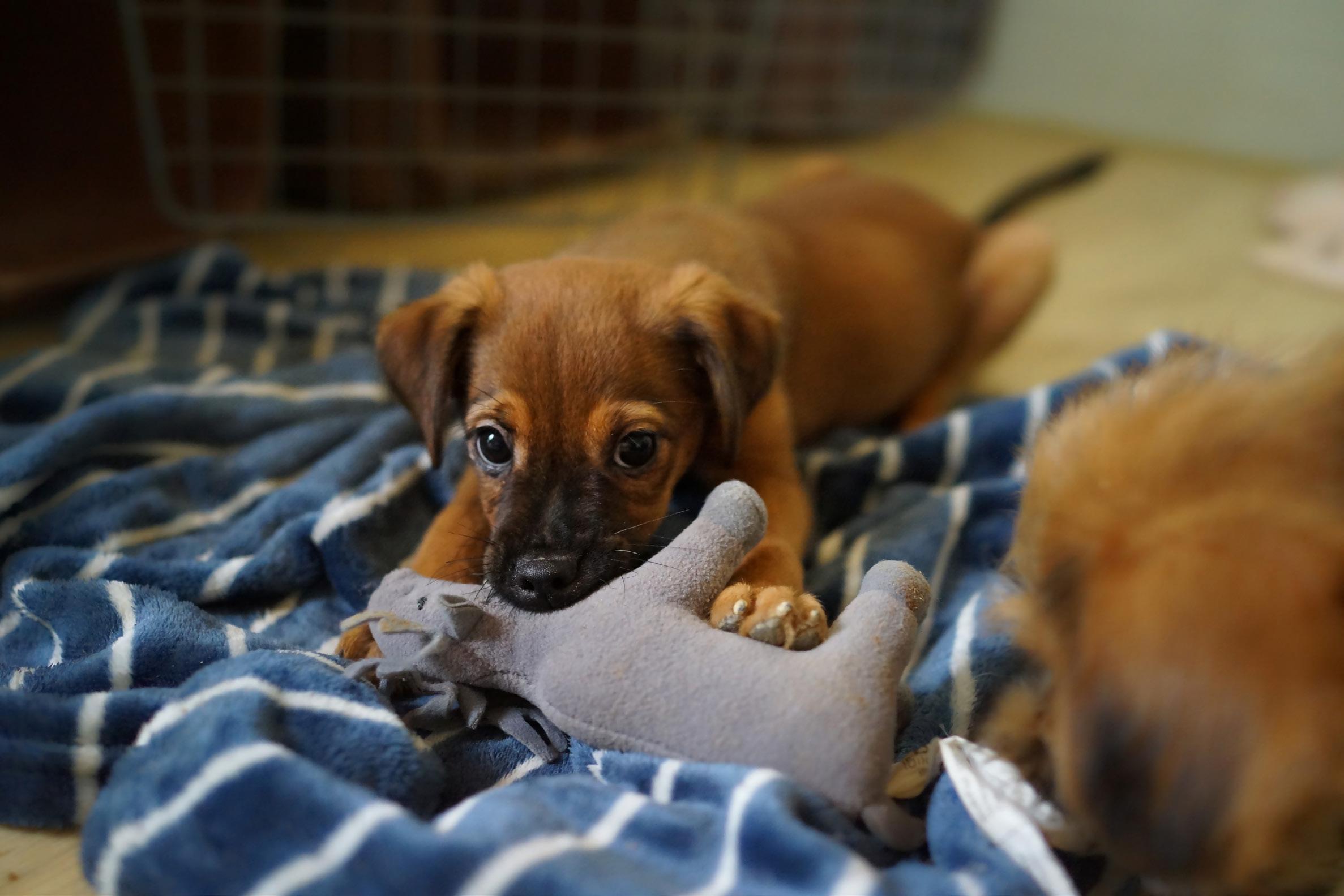
DQ | 6C 76
WELFARE
All of this might sound a little daunting, but Woodrock guides all new fosters through the entire process and is always there to help with any issues you might encounter. There is also fostering community with many longtime fosterers who are more than happy to share tips and tricks. As a final note, if the puppies need medical attention, this is covered by Woodrock and is not the financial responsibility of the foster parent.
There are many reasons people
Wanting to give back. Having a love for dogs but being unable to commit to owning one for the next tenHaving some extra time on
Fostering is time-consuming, but the rewards are massive. Seeing how the puppies grow, not only in your home while fostering but also in the updates you receive once they are in their forever home, gives you a feeling of being part of something bigger.
Plus, by helping a rescue organisation like Woodrock, you alleviate some of the pressures on them caused by limited space, resources and labour. By taking pups into your home, you free up space at the centre for even more dogs in need.

DQ | 6C 77
WELFARE
GET INVOLVED
For more information or if you would like to get involved, please get in touch with Sarah from Woodrock on 082 925 3133.
HOW DO PUPPIES IN FOSTER CARE FIND HOMES?
Woodrock uses its pop-up model to help find the puppies' homes. There are varying locations for these pop-up initiatives, and locations often change to ensure there are more pop-ups in more locations. The fosterer must bring their pups to the pop-ups but can elect to drop and collect. The puppies being at the pop-up allows people to look at the puppies available in the flesh - sometimes, a picture just does not do these pups justice. The pop-ups also provide a good way for the puppies to socialise in a safe environment.
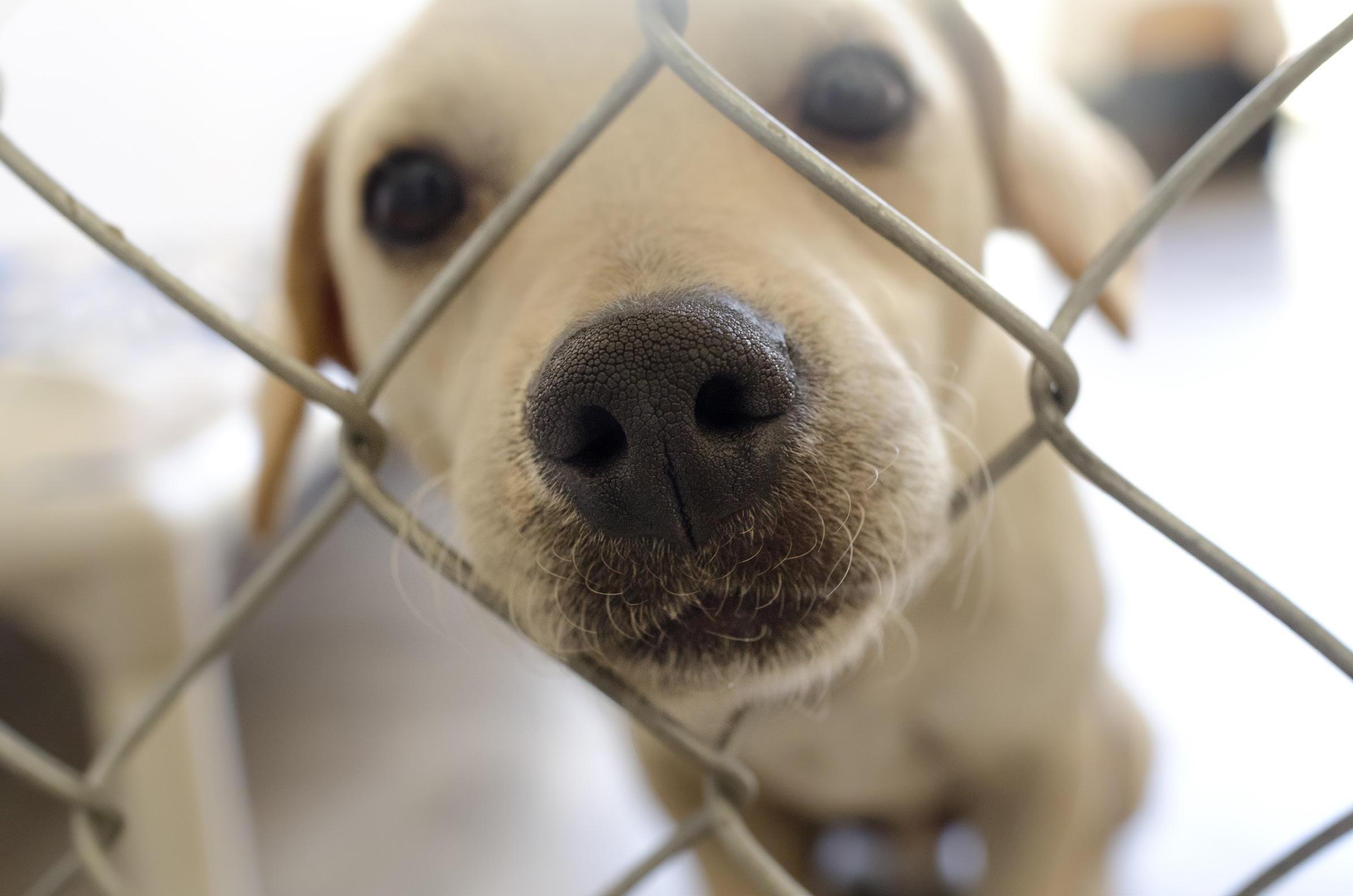
DQ | 6C 78 WELFARE
DID YOU KNOW?
Afghan Hounds can run at speeds of up to 65km/h.
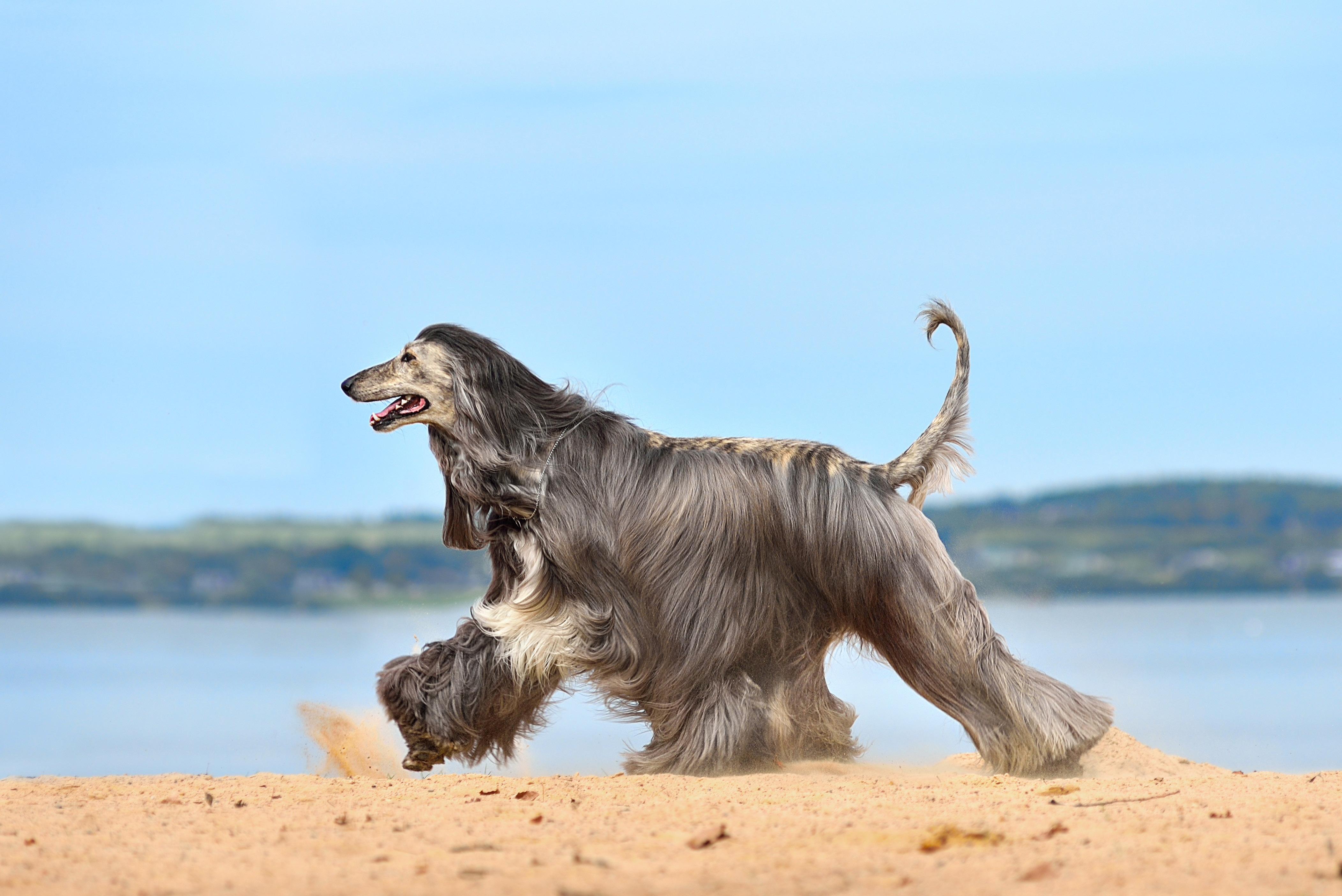
FOCUS DQ | 6C 79
What makes a dog a dog?
A dog is defined as a domesticated carnivorous mammal belonging to the family Canidae and the genus Canis. Several characteristics and attributes collectively define what makes a dog a dog:
• Species classification: Dogs belong to the species Canis lupus familiaris, a subspecies of the grey
wolf (Canis lupus). This classification distinguishes them from other animals. It means that they are a domesticated form of grey wolf and whilst they are classified within the broader species, they are a distinct subspecies due to their long history of selective breeding by humans.
• Genetic similarity: Dogs share a common ancestry with wolves. They have been selectively bred over generations for specific traits, resulting in a

DQ | 6C 80 ?
wide range of breeds with distinct appearances, behaviours, and temperaments.

• Physical characteristics: While there is a wide variation in appearance among different dog breeds, common physical characteristics include four legs, a tail, erect ears (which can vary in shape), a well-developed sense of smell, and a keen sense of hearing.
• Social nature: Dogs are pack animals, just like their wolf ancestors. They exhibit social behaviours such as forming strong bonds with humans and other dogs, displaying hierarchy within a group, and engaging in various forms of communication.
• Domestication: Dogs were one of the first animals to be domesticated by humans. This process involved selectively breeding wolves with desirable traits, leading to the development of various dog breeds. Domestication has influenced their behaviour, physiology, and appearance.
• Behavioural traits: Dogs typically exhibit a wide range of behaviours, including loyalty, playfulness, territoriality, and a strong sense of smell. These behaviours can vary depending on the breed and individual dog.
• Communication: Dogs communicate through vocalisations (barking, growling, whining), body language (tail wagging, ear positioning, facial
expressions), and scent marking. They have developed a sophisticated way of interacting with other dogs and humans.
• Cognitive abilities: Dogs have demonstrated a certain level of intelligence and problem-solving skills. They can learn commands, follow cues, and even understand some human gestures.
• Role in human society: Dogs have been companions to humans for thousands of years and have played various roles, such as hunting partners, herders, guards, and service animals. Their close relationship with humans has deeply impacted their behaviour and lifestyle.
• Diversity of breeds: The immense diversity among dog breeds, with variations in size, coat type, colour, and behaviour, showcases the adaptable nature of dogs to fulfill different roles and suit various environments.
In summary, a dog is characterised by its domesticated status, genetic relationship to wolves, physical attributes, social behaviour, communication methods, and historical and ongoing partnership with humans. These combined factors define what makes a dog a distinctive and cherished member of the animal kingdom and human society.
DQ | 6C 81 Q&A
Do all dogs have the same paw structure?
While dogs share a standard basic paw structure, there can be variations in the size, shape, and characteristics of their paws among different breeds. Here are some general features of a dog's paw structure:
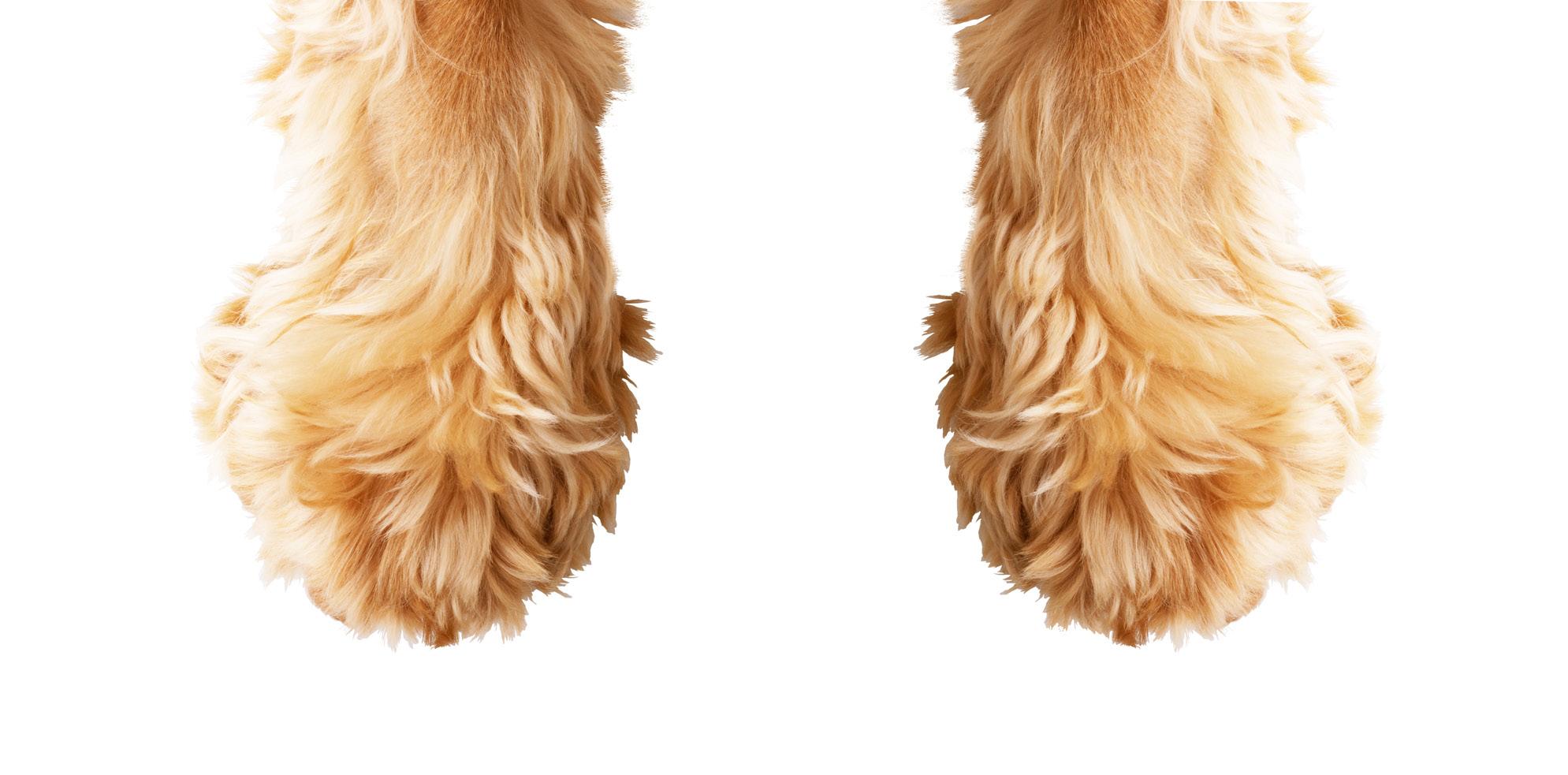
1. Digits: Most dogs have four primary toes on each paw, while some may have dewclaws (reduced digits) higher up on the leg, which are vestigial and not always present in all breeds.
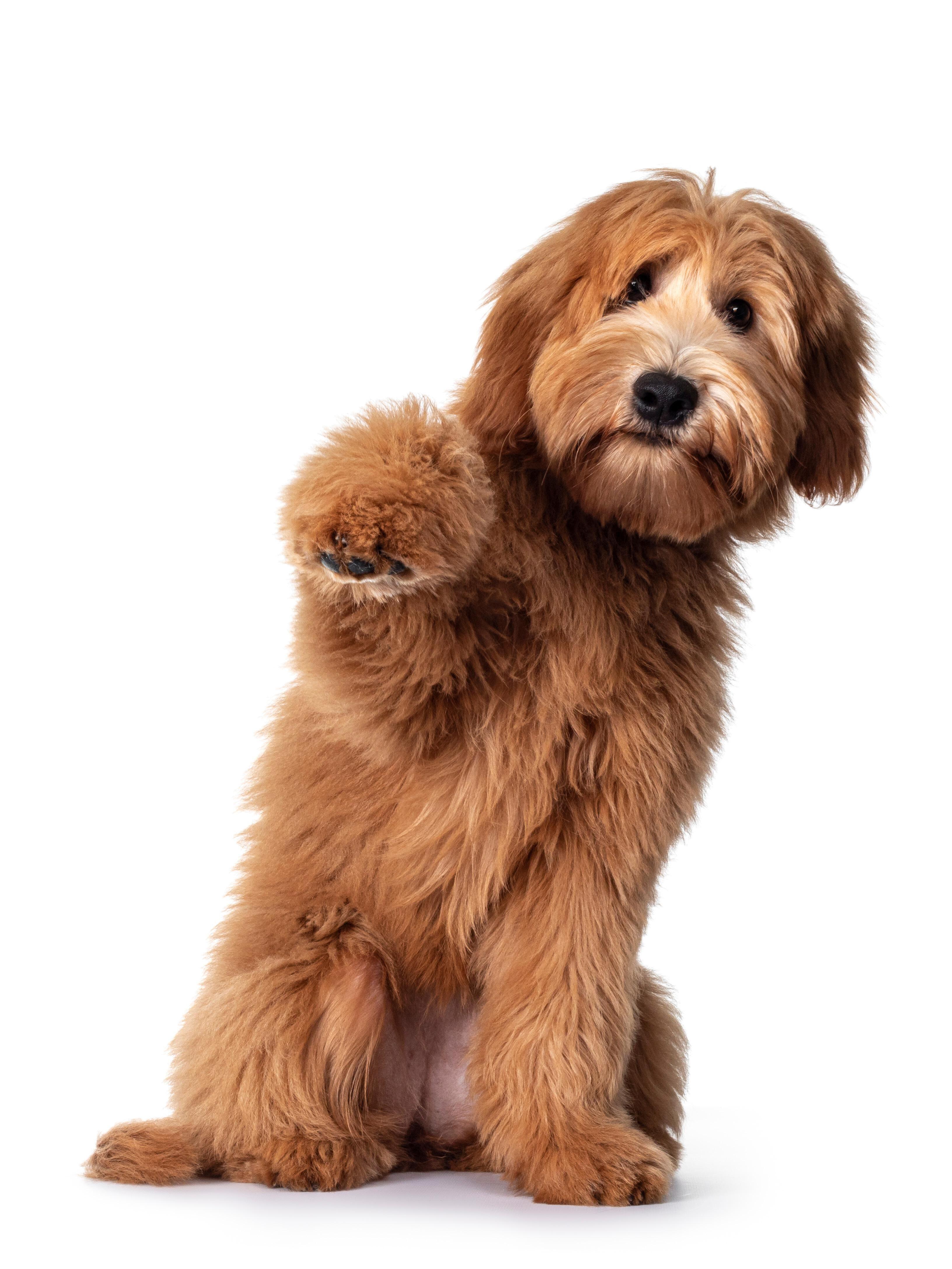
2. Nails: Dogs have non-retractable claws. These claws are used for activities such as digging, scratching, and maintaining traction while running.
3. Footpads: The bottom of a dog's paw is covered with tough, thick skin, known as the footpad. The footpads provide protection, cushioning, and insulation for the paws.
4. Digital pads: These pads are located on the underside of each toe, providing additional cushioning and traction. They help dogs maintain stability while walking or running.
5. Metacarpal and metatarsal pads: These pads are located higher up on the paw, corresponding to the 'wrist' and 'ankle' areas. They also contribute to cushioning and support.
DQ | 6C 82 Q&A
6. Paw shape and size: Different dog breeds have varying paw shapes and sizes, which are often adapted to their specific functions and environments. For example, dogs bred for running long distances might have more elongated and streamlined paws, while those bred for digging might have sturdier and wider paws.

7. Webbing: Some dog breeds have webbing between their toes. This trait is more common in breeds that are natural swimmers, as the webbing helps improve their swimming abilities.
8. Hair and fur: The fur and hair on a dog's paws can vary in thickness and length, providing additional insulation and protection against different weather conditions.

9. Scent glands: Dogs also have scent glands on their paw pads, contributing to their ability to mark territory and communicate with other dogs through scent.
In summary, while there are commonalities in the basic paw structure among all dogs, variations have evolved due to the diverse roles and environments in which different breeds have been bred. These variations contribute to the unique characteristics and abilities of various dog breeds.
DQ | 6C 83 Q&A
Products we love
PaleoPet Pure 100% Green Beef Tripe for Dogs

Humans may find tripe to be somewhat of an acquired taste (and smell), but dogs absolutely love it! Our tripe has been thoroughly washed and cleaned for you, while retaining all the nutrition of unbleached tripe. It’s easy to serve and store and has so many health benefits for adult and senior dogs especially.
Tripe is rich in trace minerals, while moderate in protein and fat. It is a great complementary raw food addition to a diet for dogs who may struggle with constipation or need foods that are easier to digest. Tripe doesn’t contain any bone, but still maintains a perfect calcium phosphorus balance, which is rare for animal protein without bone content.
Tripe can be used as a basis for a ketogenic diet for dogs with cancer or epilepsy where one should feed low
to no carbohydrate, moderate protein and high fat. Tripe can also entice dogs who may not feel all that well and are reticent to eat.
Our 100% Green Beef Tripe (and nothing else) is made from the best quality local beef with no preservatives, colourants or artificial flavourants.
The PaleoPet Pure range is FSA Food Safety certified and DALRRD registered. Also available in convenient, pre-frozen 1,5 Kg and 750g tubs or as a box of 12 individually wrapped 100g Patties. The tubs are reusable, recyclable and PBA-free.
Products can be purchased online at www.paleopetpure.com and delivered to your door or bought at selected retailers.
DQ | 6C 84
Shopping fun
DQ | 6C 85 follow us on Instagram @dogquarterlymag and Facebook dqmagazine stay tuned for the next issue of
DQ | 6C 86
www.dqmagazine.co.za 15
NEXT ISSUE





























































 Text | Bianca Rootman
Text | Bianca Rootman



































